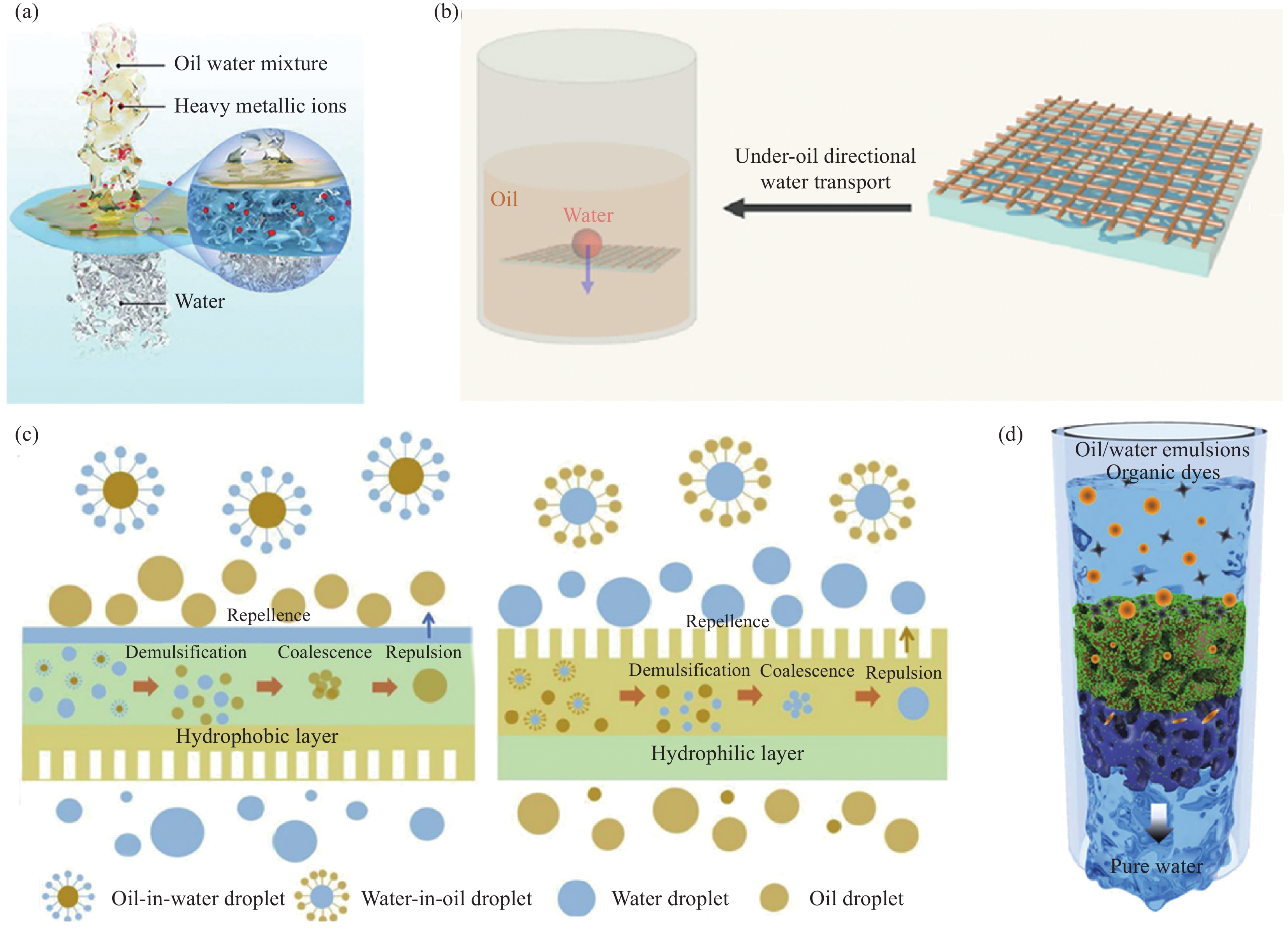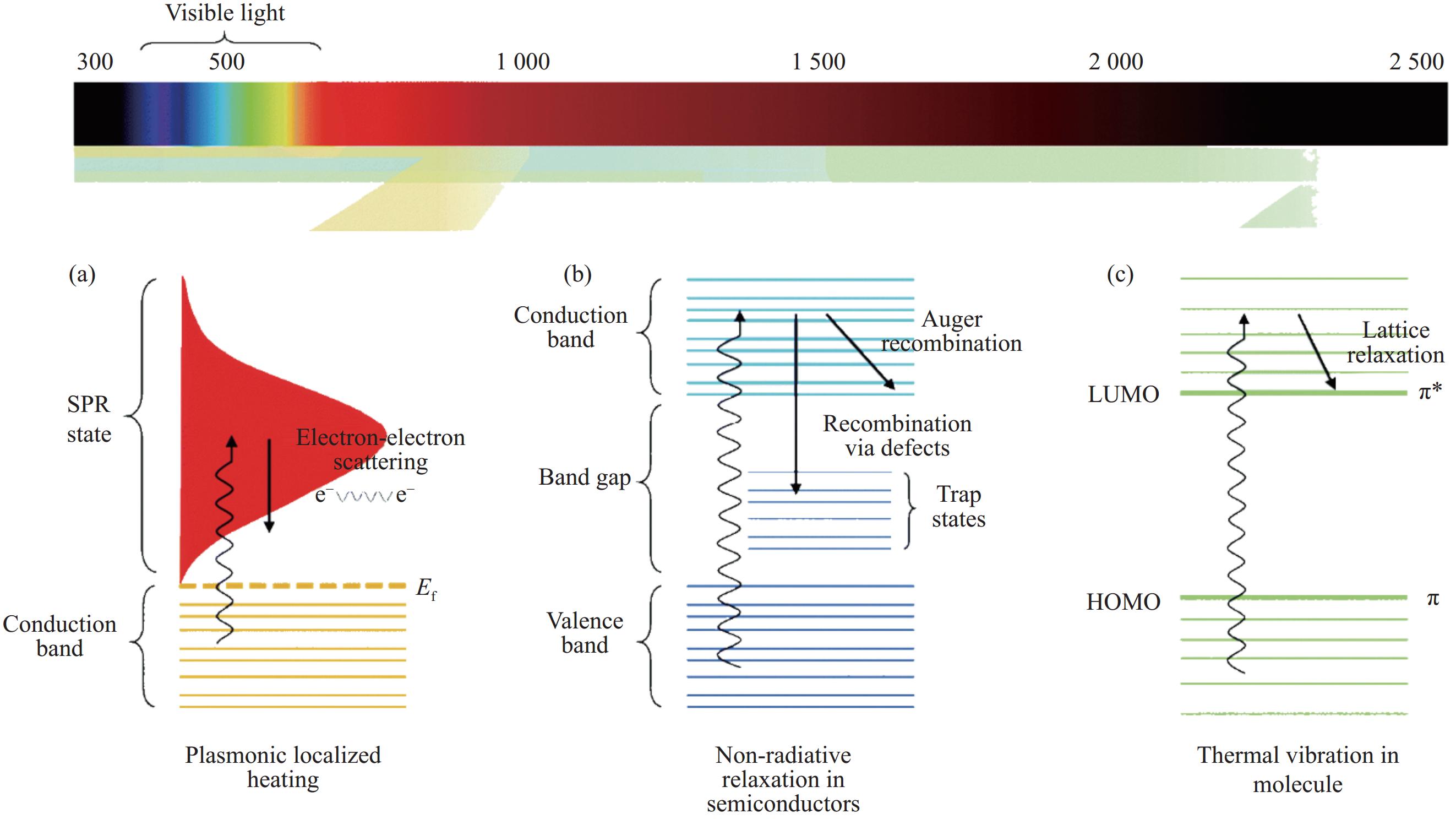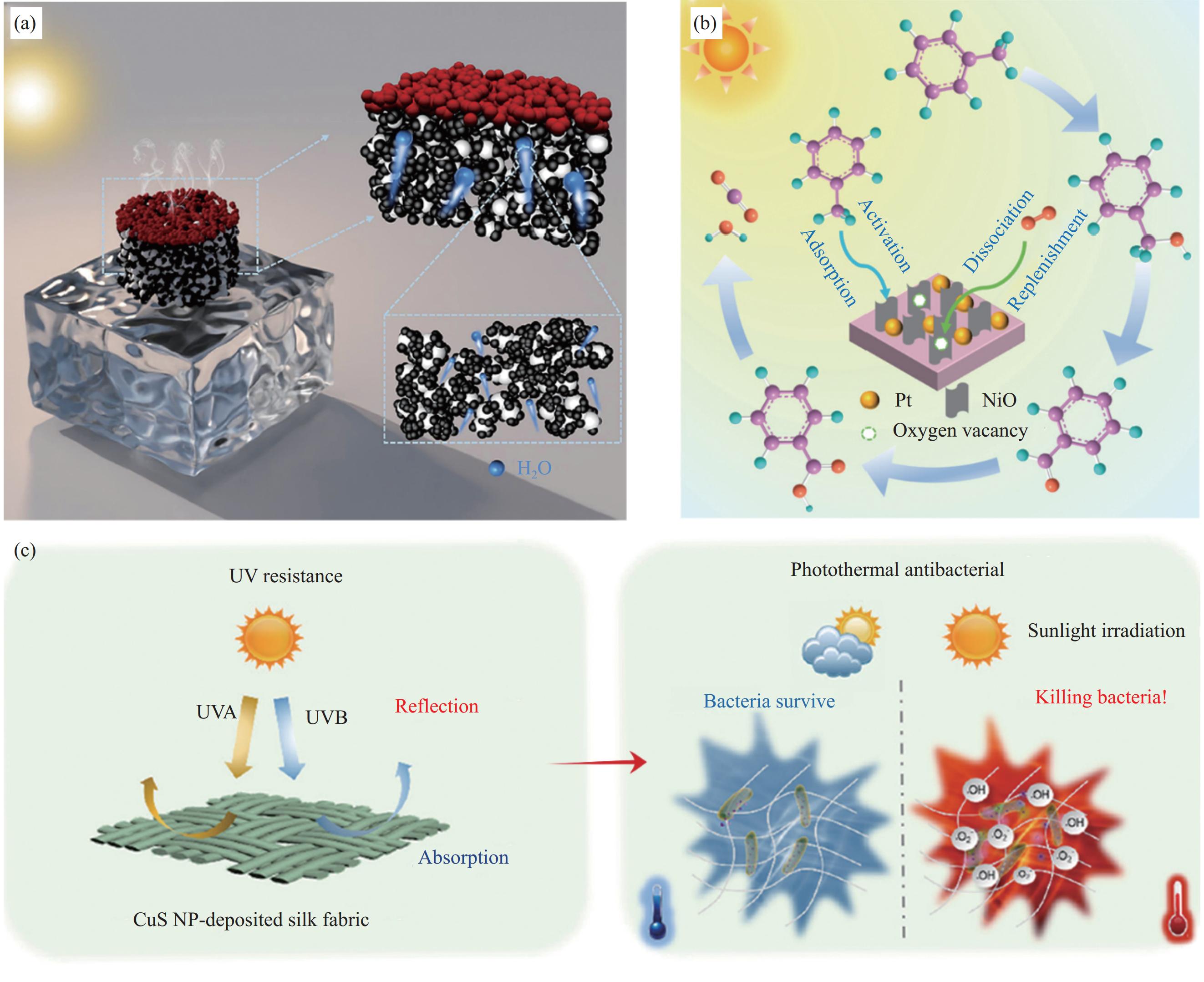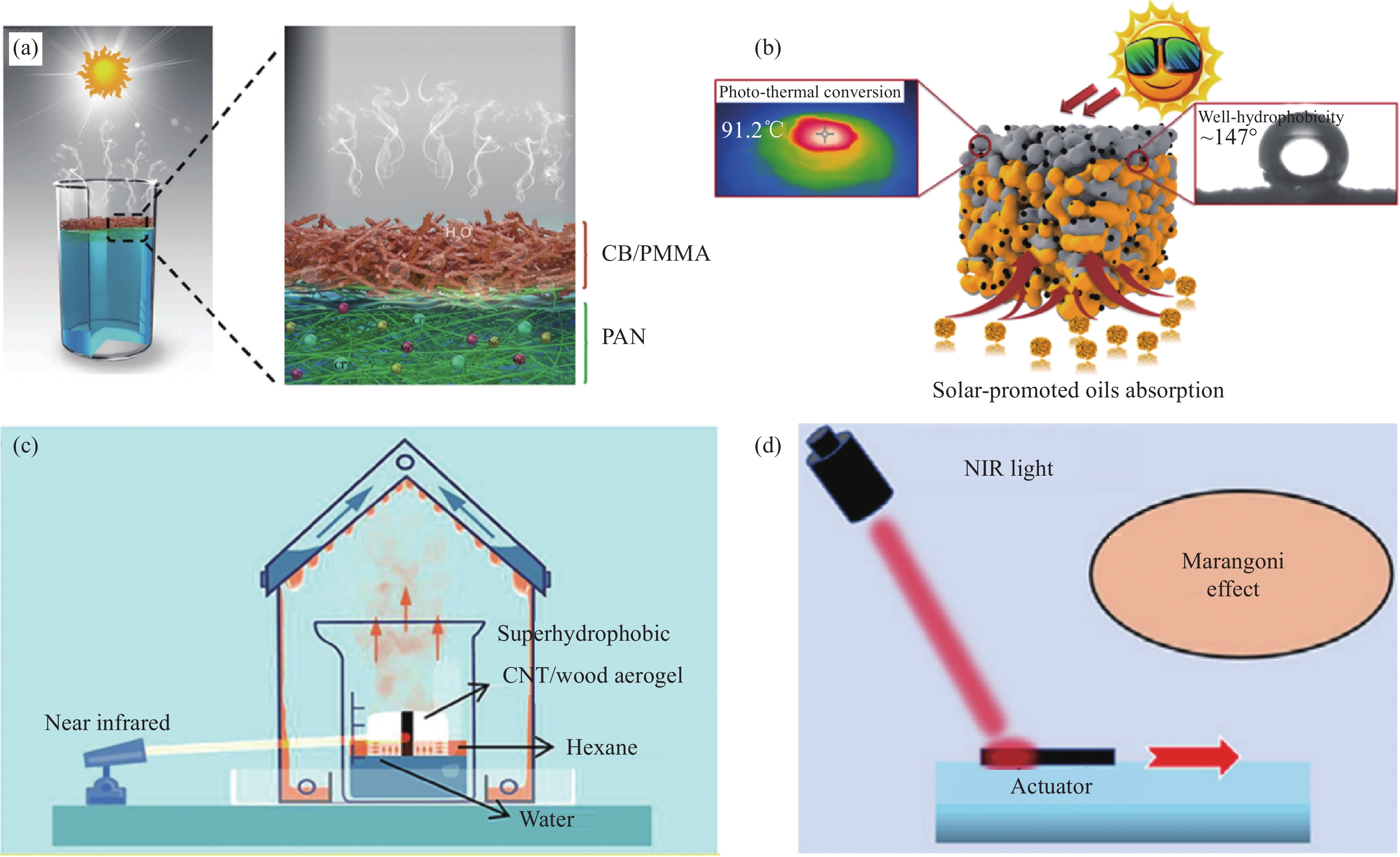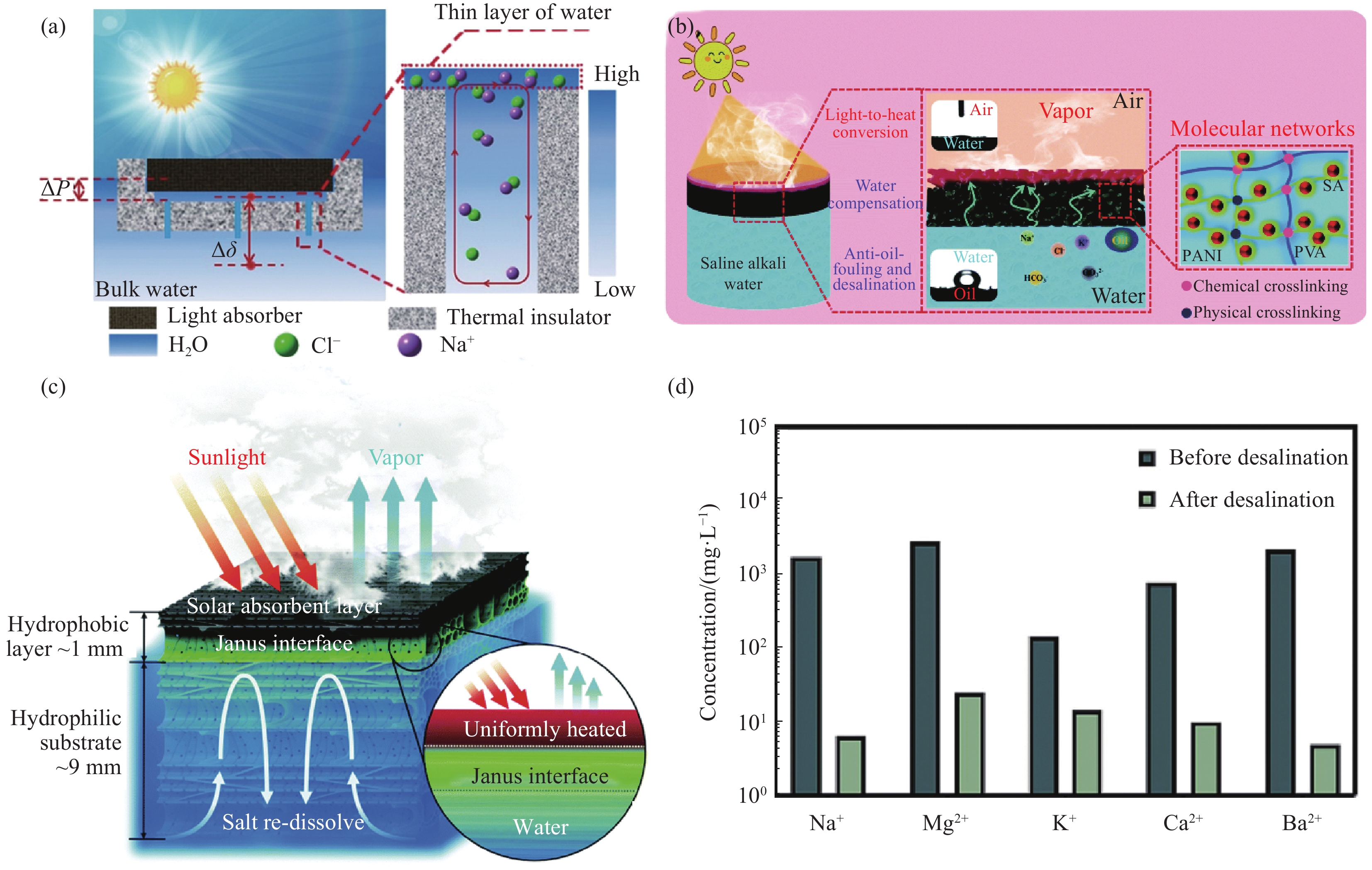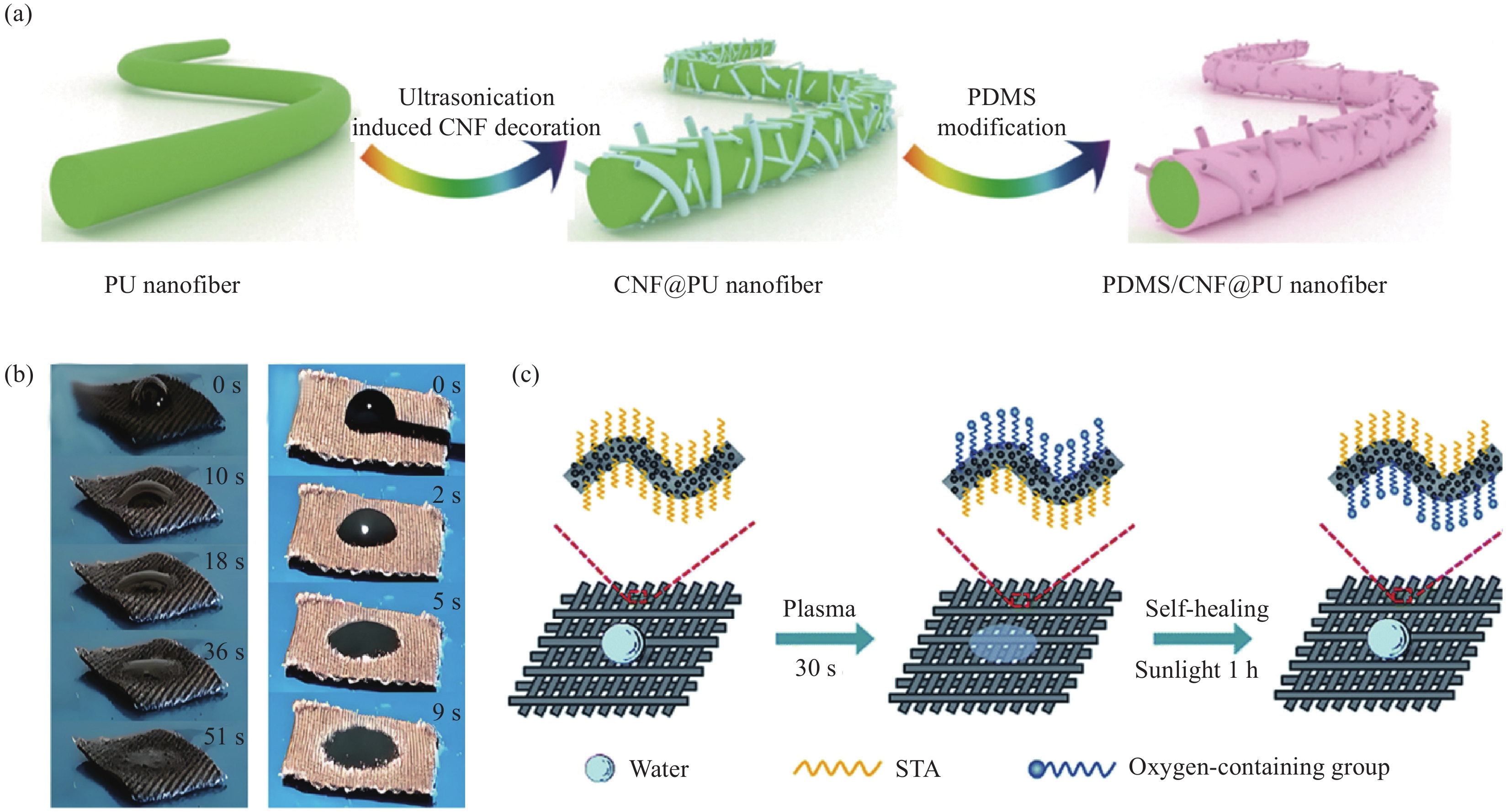Research progress on water purification composites with special wettability and photothermal effect
-
摘要:
当前全球水资源污染,淡水短缺问题日益严重,针对海水、苦咸水、工业废水及生活污水等非常规水资源净化再利用的研究显得尤为迫切,而利用特殊润湿性与光热效应协同作用为非常规水资源净化提供一种行之有效、绿色低碳的解决策略。本文首先概括常规水净化材料研究现状,明确当前技术的优劣与挑战,随后系统论述单一特殊润湿性材料与光热转换材料在水净化领域的作用机制及研究进展,深入解析特殊润湿性及光热效应在水净化应用层面的协同增效机制及工作原理,剖析二者的协同作用在太阳能利用、水净化效益、可持续性能以及应用场景等方面的优势,总结分析超浸润光热复合材料在水净化领域的应用现状。最后,对超浸润光热复合材料在水净化领域中现有的局限性和未来的前景进行阐述与展望。
Abstract:Currently, the pollution of global water resources and the scarcity of fresh water are increasingly severe. The pressing need for research on purifying and reusing unconventional water resources such as seawater, brackish water, industrial wastewater, and domestic sewage necessitates an effective, environmentally friendly, and low-carbon solution strategy that harnesses the synergistic effect of specialized wetting materials and photothermal conversion. This paper begins by summarizing the research status of conventional water purification materials while highlighting their advantages, disadvantages, and challenges in current technology. Subsequently, it systematically discusses the action mechanism and research progress of individual specialized wetting materials and photothermal conversion materials in the field of water purification. Furthermore, it thoroughly analyzes the synergistic mechanism and working principle between specialized wetting effects and photothermal effects at an application level in water purification. The analysis includes examining their advantages in solar energy utilization, benefits to water purification processes, sustainability performance aspects as well as application scenarios. Additionally summarized is an analysis of the current application status of super-wetted photothermal composites within the field of water purification. Finally, this paper expounds upon existing limitations while prospecting future prospects for super-wetted photothermal composites within the realm of water purification.
-
水是地球生命的源泉,也是人类发展的动力。世界人口快速增长、全球气候变化及工业化扩张使得现有水资源污染、淡水资源紧缺等问题日益严峻。研究表明,在2050年全球约50亿人口将面临着中度甚至更严重的缺水问题[1-2],而可直接利用的清洁水资源仅占全球水资源的2.7%。例如海水、苦咸水等复杂水系,因含盐量高无法直接使用的水资源占比高达7.3%[3-4]。并且在全球范围内淡水资源分布极不均衡,诸多国家水资源严重短缺。相关报道显示,全球每天约有200万吨的工业废水、生活污水未经处理就直接排放,进一步缩减了人类可支配的淡水资源[5]。因此,不少国家已针对水资源开展深度管理和规划,并加大对海水、苦咸水、工业废水及生活污水等水资源的治理力度,以缓解水资源紧缺的现状。随着科技进步及各行业的发展,诸多工程技术人员针对从海水或受污染水体中获取洁净淡水技术进行不断地开发与优化,研发了多种水净化技术,如膜分离[6]、光催化[7]、吸附[8]等,在水净化领域取得了较好的反响,但这些技术在成本、能耗以及设备等方面仍面临一些挑战,极大限制其实际应用,因而研究人员着力研制成本低、能耗小、效果好、无污染的新型水净化复合材料。
太阳能是地球目前储量最丰富的清洁能源[9],因其具有清洁绿色、可持续等特点,世界各国都将太阳能资源的利用作为可再生能源发展战略的重要组成部分。其中基于光热效应的光热转换在太阳能利用方式中最为广泛,目前已经有许多国家将太阳能辐射转换为热能用于海水等非常规水资源的脱盐处理以实现水体的净化[10]。随着表面仿生学和界面化学领域的快速发展,对于具有特殊润湿性复合材料的研究和开发受到科研工作者的广泛关注,并在水处理领域表现出优异的应用效果。特殊润湿性通常用于描述液体在液体/空气/固体或水/油/固体界面上接触角大于150°或小于10°的极端润湿行为[11]。在实际应用中,特殊润湿性材料对液相产生的极端润湿行为,可有效辅助光热转换材料对水资源进行净化,达到优异的净化效果。因此基于特殊润湿性与光热效应之间的协同作用,可为非常规水资源净化带来一种行之有效的解决措施。
1. 常规水净化材料的研究与尝试
目前,全球对水资源需求的日益增加及对水体质量的高度关注,激发各界研究人员对高性能净水材料的追求,在水净化领域做出了大量的研究与尝试[12]。
膜分离技术在水处理领域中占有重要地位,利用膜固有选择透过性可实现对水中组分的分离、纯化以及浓缩。Li等[13]采用简便的模板辅助法,以聚砜作为底物,在其上方覆盖聚酰胺(PA)层,并将铜纳米棒预先负载到PA中,随后利用酸对铜纳米棒进行酸刻蚀,得到含有一维(1D)纳米通道的薄膜复合膜(TFC-1D),此外还制备未经酸刻蚀的薄膜复合膜(TFC)以及含有0D纳米空隙的薄膜复合膜(TFC-0D)作为对比,以分析纳米通道尺寸对水通量及NaCl的截留率的影响。经测试,TFC-0D膜的透水性比TFC高出61%,而TFC-1D膜的水通量比TFC高出126%。经酸刻蚀后形成的空隙可提供额外的水传输路径(图1(a)),但是这也会造成NaCl的截留率下降,TFC的NaCl的截留率为(99.0±0.2)%,而TFC-0D及TFC-1D分别下降至(96.7±1.1)%、(97.3±0.6)%。Qu等[14]报道了一种复合多孔纳滤膜(GOZM),通过在氧化石墨烯膜(GOM)中嵌入尺寸可控的沸石咪唑酯骨架材料(ZIF-8),带正电的ZIF-8可以提高GOM的静电稳定性,在保证高透水性的同时,还表现出良好的染料筛选性能(图1(b))。与膜过滤不同的是,Shen等[15]使用光催化法对染料污染物进行降解,以碳纤维(CF)布为基材,采用浸涂和热凝结法在其表面完成C3N4纳米片生长,制备出光催化型CF/C3N4滤布复合材料。在可见光照射下,面积为16 cm2的CF/C3N4滤布在1 h内可降解废水中98%的罗丹明B。随着对光催化材料研究的逐渐深入,研究人员发现将生物炭与光催化剂复合,借助生物炭增强电子-空穴对的转移,进而阻止电荷复合,可有效提高光催化剂的催化活性。例如,Gonçalves等[16]以廉价无毒的咖啡渣(COFF)废料为生物碳源,通过共沉淀法制备了ZnO/2-COFF复合材料。在评估其光催化性能时,以苯酚为污染物模型,在60 min内ZnO对苯酚的降解效率只有40%,而ZnO/2-COFF对苯酚的降解效率可达65%。
![]() 图 1 (a)含有零维(0D)纳米空隙的薄膜复合膜(TFC-0D)以及含有一维(1D)纳米通道的薄膜复合膜(TFC-1D)水分输运机理示意图[13];(b)在CA载体上制备复合多孔纳滤膜(GOZM)的实验过程示意图及其选择性保留染料分子的分离机理示意图[14];(c) MOF颗粒(ZIF-67)染料吸附机理示意图[20];(d) Ti/Ti4O7电化学氧化示意图[22]Figure 1. (a) Schematic diagram of TFC-0D and TFC-1D water transport mechanisms[13]; (b) Schematic diagram of the experimental process of preparing GOZMs on CA carrier and the separation mechanism of their selective retention dye molecules[14]; (c) Schematic diagram of ZIF-67 dye adsorption mechanism[20]; (d) Schematic diagram of electrochemical oxidation of Ti/Ti4O7[22]PSF—Polysulfone; PA—Polyamide; TFC-0D—0D nanovoids contained thin-film composite (TFC); TFC-1D—1D nanochannels contained TFC; MnB—; RB—; CA—; GOZM—; ZIF-67—Zeolite imidazole framework-67
图 1 (a)含有零维(0D)纳米空隙的薄膜复合膜(TFC-0D)以及含有一维(1D)纳米通道的薄膜复合膜(TFC-1D)水分输运机理示意图[13];(b)在CA载体上制备复合多孔纳滤膜(GOZM)的实验过程示意图及其选择性保留染料分子的分离机理示意图[14];(c) MOF颗粒(ZIF-67)染料吸附机理示意图[20];(d) Ti/Ti4O7电化学氧化示意图[22]Figure 1. (a) Schematic diagram of TFC-0D and TFC-1D water transport mechanisms[13]; (b) Schematic diagram of the experimental process of preparing GOZMs on CA carrier and the separation mechanism of their selective retention dye molecules[14]; (c) Schematic diagram of ZIF-67 dye adsorption mechanism[20]; (d) Schematic diagram of electrochemical oxidation of Ti/Ti4O7[22]PSF—Polysulfone; PA—Polyamide; TFC-0D—0D nanovoids contained thin-film composite (TFC); TFC-1D—1D nanochannels contained TFC; MnB—; RB—; CA—; GOZM—; ZIF-67—Zeolite imidazole framework-67在水净化技术中,吸附技术具有操作简单灵活、吸附能力高效、易再生等特点,是去除水中污染物较为常用的技术。Demirbas等[17]采用榛子壳基活性炭作吸附剂对水溶液中的Cu2+进行吸附,该活性炭对Cu2+的最大吸附量为58.27 mg/g。因注意到在实际应用中活性炭的粉末结构常常会阻碍其后续回收再利用过程,部分研究人员制备了可进行磁分离的活性炭。例如,Wu等[18]采用共沉淀法制备磁性木质素基活性炭(LMAC),利用永磁体可轻易的将LMAC从水溶液中分离出来。另一方面新型MOF复合材料也被评价是一种高效的吸附材料,可有效吸附废水中的污染物[19]。Li等[20]将静电纺丝技术与喷涂工艺相结合,将MOF颗粒(ZIF-67)嵌于静电纺丝膜(PCF)中,得到一种新型的纤维内部镶嵌颗粒结构的MOF织物(PIF-PZ)。如图1(c)所示,借助孔雀石绿(MG)与ZIF-67之间的π-π堆积作用可使得PIF-PZ对MG的吸附容量达到198.1 mg/g。Jia等[21]受自然生物矿化的启发,以淀粉样蛋白原纤维作为金属有机框架(ZIF-8)的载体,开发出一种淀粉样蛋白原纤维/ZIF-8混合气凝胶,凭借ZIF-8高效吸附能力及金属-蛋白质之间的螯合作用,该气凝胶可有效地从水中去除9种不同的重金属离子。为有效对复杂废水体系中的污染物进行深度处理,Zhi等[22]利用电化学法,将制备得到的Ti/Ti4O7、Ti/RuO2-IrO2作为阳极并应用于焦化废水和煤气化废水处理,在电化学氧化过程中Ti/Ti4O7阳极相较于Ti/RuO2-IrO2阳极具有更低的氧生成副反应以及更高的电流效率(65.5%),且Ti/Ti4O7阳极表面形成的A~•OH具有更高的电化学活性(图1(d)),使得Ti/Ti4O7阳极COD去除率(78.7%)高于Ti/RuO2-IrO2阳极COD去除率(53.5%)。Luo等[23]发现使用石墨烯电极(E-CP)进行电化学活化可以显著加速高碘酸盐(PI)对微污染物的高级氧化降解。E-CP/PI系统在15 min就可完全去除双酚A(BPA),并且E-CP/PI系统展现杰出的pH耐受性,在pH值3~9的范围内都对BPA有着良好的降解效果。
由表1[24-37]可知,虽然常规水净化材料针对目标污染物已经取得较好的处理成效,但是在实际应用中仍存在诸多限制,如成本较高、二次污染、需要能源供给、依赖特定设备等,这在偏远及贫困地区难以推广应用。为解决这一问题,科研人员将目光转向储存量大、分布范围广、清洁绿色的太阳能资源,并以此开发新型的水净化材料,在满足绿色可持续发展的前提下,实现高效的水净化效果。
表 1 不同类型的水净化材料对比Table 1. Comparison of different types of water purification materialsType Advantage Disadvantage Target contaminant Ref. Membrane
typeLow cost, easy to operate and good effect Limited permeability, low selectivity,
high energy consumption and serious
secondary pollutionOil, emulsion, dye, NaCl,
heavy metal ion, bacteria[24-27] Photocatalytic type Low cost, non-toxic and good chemical stability Low conversion efficiency and weak catalytic activity Organic pollutants, heavy
metal ion[28-30] Adsorption
typeSimple design, flexible implementation and easy regeneration Difficulty in recycling and has secondary pollution Dye, oil, antibiotic, heavy
metal ion[31-33] Advanced oxidation type High catalytic capacity and
good stabilitySecondary pollution, dependent on equipment Heavy metal ion, pharmaceutical contaminant, micropollutant, bacteria [34-35] Flocculation type High efficiency, low cost and
easy operationDifficulty in recycling Suspended solid, heavy
metal ion, dye[36-37] 2. 特殊润湿性与光热效应协同在水净化中的增效机制
随着表面仿生学和界面化学领域的快速发展,对于具有特殊润湿性复合材料的研究和开发受到科研工作者的广泛关注。研究发现,利用特殊润湿性与光热效应之间的协同作用,所构筑的超浸润光热复合材料可有效提高太阳能整体利用率及水净化效果。
2.1 单一特殊润湿性材料的水净化研究进展
近年来,单一特殊润湿性材料在油水分离、染料吸附及重金属离子去除等水净化领域展现出了巨大的应用潜力。Chen等[38]利用多巴胺(PDA)和植酸(PA)对木质素基聚氨酯泡沫(LPUF)表面进行改性,得到具有超亲水/水下超疏油性生物基聚氨酯泡沫(LPUF/PDA/PA)。在PDA较大的表面粗糙程度以及PA高亲水性的协同作用下,致使LPUF/PDA/PA拥有超亲水性能。当泡沫接触水组分时,水相会优先接触泡沫表面,泡沫的超亲水表面可以捕获和保留水分子,使水占据表面的粗糙结构,在泡沫表面形成水化层,阻止油相与泡沫表面接触,从而使泡沫实现油水分离。经测试,LPUF/PDA/PA对正己烷/水、环己烷/水、甲苯/水及泵油/水等油水混合物的分离效率可达99%。Wu等[39]采用一步沉积工艺,将松粉沉积到聚偏氟乙烯膜上构制水下超疏油和油下超疏水分离膜,能有效分离多种类型的油水乳液。Zhang等[40]采用简单的溶胶喷涂、化学交联和冷冻干燥法成功制备柠檬酸改性海藻酸盐基气凝胶膜(ALG-CIT),柠檬酸改性后的气凝胶膜表面拥有更多的亲水基团,使得ALG-CIT呈现超亲水性。ALG-CIT为夹层结构,内部平均孔径在50 μm左右,独特的夹层设计及小口径可有效防止微小油滴通过,保证ALG-CIT高效的油水分离效率(图2(a)),且膜表面和内部富含羧基和氮原子,能有效络合水中的重金属离子,从而达到高效净水效果。
![]() 图 2 (a)膜在油水分离和重金属离子吸附示意图[40];(b) Janus多孔膜实现油下定向水传输[43];(c) Janus膜针对不同油水乳液的分离机理[44];(d) Janus海绵用于同时去除染料污染物和油/水乳液分离[46]Figure 2. (a) Schematic diagram of film used in oil-water separation and heavy metal ion adsorption[40]; (b) Janus porous membranes enable directional water transfer under oil[43]; (c) Janus membrane for the separation mechanism of different oil-water emulsions[44]; (d) Janus sponge is used to simultaneously remove dye contaminants and oil/water emulsion separation[46]
图 2 (a)膜在油水分离和重金属离子吸附示意图[40];(b) Janus多孔膜实现油下定向水传输[43];(c) Janus膜针对不同油水乳液的分离机理[44];(d) Janus海绵用于同时去除染料污染物和油/水乳液分离[46]Figure 2. (a) Schematic diagram of film used in oil-water separation and heavy metal ion adsorption[40]; (b) Janus porous membranes enable directional water transfer under oil[43]; (c) Janus membrane for the separation mechanism of different oil-water emulsions[44]; (d) Janus sponge is used to simultaneously remove dye contaminants and oil/water emulsion separation[46]目前,Janus型材料凭借其不对称润湿性实现液体的定向渗透,而引起广泛关注。Zheng等[41]和Lyu等[42]分别以纤维素材料和尼龙膜为基材制备出具有不对称润湿性的Janus膜,其一侧具有超疏水性,而另一侧具有超亲水性,可实现对油包水乳液及水包油乳液的分离应用。Wang等[43]使用超亲水吸水棉与疏水性铜网组建一种集成式的Janus多孔膜,通过调整铜网的孔径可对水分输送速度进行控制,在油环境中实现自发、可控地输送水滴(图2(b)),为油下分离技术提供了可行的思路。Zhang等[44]利用多酚研制出具有不对称润湿性的Janus复合膜。对于水包油乳液,该Janus复合膜可在亲水层表面形成稳定的水化层,加之膜孔具有强大的物理屏障作用,可将大部分油滴排除在膜外。在压力的驱动下,一些小油滴随水组分进入膜内后会被疏水层阻挡,从而停留在亲水层中。小油滴继续聚集成大油滴,经破乳通过亲水层从膜中排出。对于油包水乳液,底面的聚二甲基硅氧烷具有低表面能的烷基链可捕获大多数水滴。小水滴进入疏水层后继续汇聚成大水滴,由疏水层从膜中排出,实现对油水乳液的转换分离(图2(c))。Chen等[45]采用界面自组装的方法制备得到Janus复合膜,该复合膜对染料分子表现出优异的截留能力。考虑到染料吸附需要一定时间,在染料被完全吸附之前,染料组分很容易随滤液一起过滤,导致染料净化效率较低。为解决这一问题,Zeng等[46]设计了一种3D Janus材料(图2(d)),通过控制其疏水层和亲水层的厚度来调整油/水乳液与染料的分离效率以及分离通量,为在复杂条件下实现不同分离需求开辟一条新途径。
尽管已经开发出诸多具有特殊润湿性的界面材料,但是随着各行业对材料智能性、多样化需求的提高,仅具有单一特殊润湿效果的功能化材料不能有效解决现今在水净化领域存在的诸多难题,亟需进一步丰富特殊润湿性材料的多用途性质,故当前相关研究人员将特殊润湿性材料与其他环境刺激响应协同,进而构筑水净化性能突出的功能性复合材料以满足各异复杂场景的应用需要。
2.2 光热效应参与水净化作用机制
由于化石能源消耗日益增加及其对环境造成不可逆转的破坏,长期以来新能源的开发与利用一直是世界关注的焦点。使用绿色清洁、取之不尽、用之不竭的太阳能取代传统的不可再生能源,符合当今可持续发展战略,有望缓解能源和环境紧张局势。
目前,根据不同产热机制,提出了3种光热效应机制,分别是等离子体共振热效应、半导体非辐射弛豫和分子热运动[47]。等离子体纳米结构可通过电子跃迁的方式吸收入射光子能量,当光子能量与自由电子集体振荡频率相匹配时,会发生强烈共振作用,从而产生极高热量(图3(a)),并通过热传导将热能传递到环境中[48-49]。如图3(b)所示,半导体材料经太阳光辐射后,若入射光子能量(Eph)高于半导体带隙能量(Eg)时,半导体材料会激发跃迁产生电子-空穴对[50],当能量以声子形式的非辐射弛豫来释放时,会导致晶格局部温度升高,进而向外传递热能。碳基材料与一些有机聚合物内部具有丰富的π键,其电子结合强度较弱,因此即使辐射能量较低也可使电子从π轨道激发到π*轨道,当入射光能量满足内部电子跃迁时,π电子会从基态(最高占据分子轨道(HOMO)),激发到更高的能量状态(最低未占据分子轨道(LUMO)),在电子-声子耦合弛豫到基态后,会引起晶格振动,从而产生热量,以实现材料表面宏观温度升高(图3(c))[51-52]。
![]() 图 3 光热效应的3种机制及其相应的光吸收范围:(a)等离子体共振热效应;(b)半导体非辐射弛豫;(c)分子热振动[49]Figure 3. Three mechanisms of the photothermal effect and their corresponding light absorption ranges: (a) Thermal effects of plasmon resonance; (b) Nonradiative relaxation in semiconductors; (c) Molecular thermal vibration[49]SPR—; Ef—; LUMO—; HOMO—
图 3 光热效应的3种机制及其相应的光吸收范围:(a)等离子体共振热效应;(b)半导体非辐射弛豫;(c)分子热振动[49]Figure 3. Three mechanisms of the photothermal effect and their corresponding light absorption ranges: (a) Thermal effects of plasmon resonance; (b) Nonradiative relaxation in semiconductors; (c) Molecular thermal vibration[49]SPR—; Ef—; LUMO—; HOMO—如今在水净化方面,光热效应主要应用在水淡化[53]、污染物降解[54]、灭菌[55]等领域。诸多研究人员利用光热转换材料对太阳光进行捕获,将其转换为热能,用来加速材料表面及内部的水分蒸发,实现水资源淡化。例如,Xiong等[56]以超长羟基磷灰石纳米线当作载体对钯纳米颗粒进行固定,并将其作为骨架与壳聚糖进行组装形成多功能集成式仿生气凝胶,经测试在1个太阳强度下该气凝胶蒸发界面的平均温度为30.9℃,蒸发速率可达到1.78 kg·m−2·h−1。Zhao等[57]制备了一种以聚吡咯超分子为填充网络的气凝胶(DVP@SPPy),用于高效海水淡化(图4(a)),干态的DVP@SPPy在
1000 W·m−2太阳强度下辐照600 s后其表面温度急剧升高并且稳定在93℃,具有出色的光热转换性能,且蒸发速率最高可达3.61 kg·m−2·h−1。Qin等[58]报道了一种由超长羟基磷灰石纳米线(HAP)和碳纳米管(CNT)涂层组成的自浮式HAP/CNT双层气凝胶基太阳能驱动水蒸发器,用于海水淡化和废水净化。在1000 W·m−2太阳强度下,HAP/CNT双层气凝胶蒸发速率达到1.34 kg·m−2·h−1,在户外测试中,冷凝水的产量达到4.5 kg·m−2,可满足两个成年人的日常饮用水需求。在针对水资源体系内部分污染物进行处理时,研究人员发现,利用光热效应可提高一些特定材料的催化/活化性能,加速污染物降解速率。例如,Zhang等[59]开发了一种光热活化过氧化二硫酸盐(PDS)的方法,以炭黑为光热转化剂,在模拟太阳光下利用光热效应提高了反应溶液的升温速率和平衡温度,加快了PDS对污染物的降解速率,在180 min内可去除水溶液中约95%的磺胺甲噁唑。Gao等[60]以Pt纳米颗粒作为催化剂,使用富含氧空位的NiO纳米片充当添加组分,得到了性能优异的单片催化剂。如图4(b)所示,在太阳光作用下,单片催化剂的催化性能得到大幅提高,加快对气态氧的解离速度,从而持续补充降解甲苯所需的晶格氧,保证对甲苯高效的降解速率。此外,Ren等[61]通过在织物表面沉积硫化铜纳米颗粒(CuS NPs)构建光热抗菌织物,CuS NPs在光热转换过程中会释放•O2−与•OH从而对金黄色葡萄球菌和大肠杆菌细胞膜进行破坏,使细菌细胞内营养物质流失,进而在极短时间内实现显著的抗菌效果(图4(c))。同样,Zhang等[62]制备了光热纳米颗粒(FeTGNPs),利用FeTGNPs优异的光热性改变细胞膜通透性,从而恢复抗生素对耐药菌的灭菌效果。
2.3 基于特殊润湿性与光热效应的水净化原理
目前,特殊润湿性与光热效应进行协同作用主要体现在对光热转换材料润湿性的改善,在多相水体系环境中展现出显著的应用价值。
在光热转换材料对水资源进行淡化时,需保证材料具备优异的水分输送能力,为水分在蒸发界面进行高效蒸发提供保障。近些年研究人员除选用亲水性较好的材料如木材[63]、织物[64]、生物碳[65]等作为基材外,也经常将Janus不对称润湿模型应用于光热转换材料中[66],所制备的超浸润光热复合材料在太阳光照射下,其背光侧可凭借其超亲水性加快水分子从下层水体向太阳能光热转换界面运输的速度,为水分高效蒸发创造条件,而处于气液交换界面的光热层借助自身超疏水性又确保其稳定浮于水面吸收阳光,摆脱传统光热转换材料对漂浮层的依赖。Xu等[67]发现凭借Janus不对称润湿模型的特殊润湿性可有效降低在蒸发过程中盐分的堆积(图5(a)),并且因超疏水层的存在,大大减少蒸发界面向水体中传递的能量,使得超浸润光热复合材料在较长时间内都保持稳定蒸发速率。Chen等[68]使用计算机断层扫描(CT)成像技术对制备的Janus蒸发器内的盐分布情况进行分析,发现疏水层基本没有盐分堆积,而亲水层显示出大量盐分堆积。并且凭借其优异的脱盐性能,该蒸发器可连续运行400 min。
![]() Figure 5. (a) Schematic diagram of Janus-type solar evaporator desalination and its salt resistance[67]; (b) Promotes the oil phase absorption process under sunlight[71]; (c) Oil phase evaporation and its collection process[72]; (d) Schematic diagram of the motion of an object caused by the Marangoni effect[73]CB—Carbon black; PMMA—Polymethylmethacrylate; PAN—Polyacrylonitrile; CNT—Carbon nanotubes
Figure 5. (a) Schematic diagram of Janus-type solar evaporator desalination and its salt resistance[67]; (b) Promotes the oil phase absorption process under sunlight[71]; (c) Oil phase evaporation and its collection process[72]; (d) Schematic diagram of the motion of an object caused by the Marangoni effect[73]CB—Carbon black; PMMA—Polymethylmethacrylate; PAN—Polyacrylonitrile; CNT—Carbon nanotubes如今原油频繁泄露不仅造成资源浪费,而且还严重危害生态环境与人体健康。在针对多相水体系进行淡化时,如含油水资源,传统光热蒸发材料经常会被油类等污染物堵塞空隙,从而减缓水分传输速度,导致蒸发速率下降。而超浸润光热复合材料可凭借其独特的润湿性能对油类污染物实现抵抗效果,进而使得超浸润复合光热材料在含油体系淡化过程中仍能保持较为稳定的蒸发速率[69]。Ma等[70]利用天然高粱秸秆制备了具有优异的抗油性能超浸润光热复合材料,在一个太阳强度下,即使在含油卤水中进行光热蒸发,其蒸发速率也达到了3.42 kg·m−2·h−1。
此外,研究发现,在面临因高黏度原油流动性差导致吸油困难的情况时,采用光热效应相比于传统加热法更为简便有效。如图5(b)所示,通过温度升高降低油相黏度,促进油相快速流动,进而提高黏性油吸收效率[71]。目前在进行油水分离时,常通过挤压的方式收集油相,过程繁琐、缓慢。Zhu等[72]巧妙将特殊润湿性与光热效应结合,使得在太阳光照射下,加速被吸收油相的挥发,进而实现油相高效收集(图5(c))。同样,Wu等[73]利用近红外光对超浸润光热复合材料进行辐照,使其不断加热周围水体,在水面上产生局部的温度梯度,进而产生表面张力梯度,利用马兰戈尼效应为超浸润光热复合材料提供推动力,实现光驱动以便于油相回收(图5(d))。
如表2[74-85]所示,通过特殊润湿性与光热效应之间的协同作用,为光热转化材料在复杂环境下进行净化提供了可行有效的解决方案。借助对光热转化材料特殊润湿性的改变,可有效减免水体系内盐分及油相等对复合材料的影响,以保持高效水净化性能。同时,超浸润光热复合材料利用光热效应可实现对油相进行精准分选吸收,在资源回用及水资源净化方面实现双赢,符合当今绿色可持续发展规划,在水净化领域有着巨大应用潜力。
表 2 不同类型的超浸润光热复合材料对比Table 2. Comparison of different types of superwetting photothermal compositesType Main application Ref. Superhydrophilic Increase the water exchange rate to ensure continuous photothermal
evaporation and contaminant removal[74-76] Superhydrophilic and superoleophobic Resist oil pollution and ensure the smooth flow of water transportation pipeline [77-79] Superhydrophobic and superoleophilic Adsorption of viscous oil phase/optically-driven [80-82] Asymmetric wettability (Janus structure) Self-cleaning to avoid the effects of salts and other contaminants on the material [83-85] 3. 超浸润光热复合材料的水净化应用现状
利用特殊润湿性与光热效应之间的协同作用,二者相辅相成,使得超浸润光热复合材料展现出优异的性能。借助超浸润光热复合材料的特性,使其在水净化领域,包括海水及苦咸水净化、工业废水及生活污水净化、含油废水净化等方向均表现出令人满意的应用性能。
3.1 自然界盐水体系脱盐净化
对海水及苦咸水进行净化是应对全球清洁水危机最实用的方法之一[86],目前常用的水处理技术虽然能实现一定程度的海水/苦咸水净化,仍存在能耗大、成本高、二次污染等问题[87]。而基于界面太阳能水蒸发技术衍生出的各种超浸润光热复合材料可作为一种优异的含盐水系净化材料,在保证低成本、无污染前提下,仍能展现出色的处理效果。
针对海水淡化时,因盐分堆积导致材料空隙堵塞及蒸发速率下降等问题,研究人员做了诸多努力。例如,Song等[88]以天然亚麻纤维(Linen fiber,LF)为基材,通过简单的喷涂工艺得到蜡烛烟灰涂层的亚麻织物(LFS),使亚麻织物具有高效吸光性(98.5%)及超亲水性。如图6(a)所示,以LFS作为材料的太阳能接收层,聚苯乙烯泡沫作为热管理层,组建了太阳能蒸发器(LFSTM),利用LFSTM内水过渡层与底部水之间形成的盐分浓度梯度(Δδ)以及二者之间的液位差(ΔP),可解决因供水不足导致盐沉积的问题。在1个标准太阳光强下,利用LFSTM对20wt% NaCl溶液进行淡化6 h后,蒸发器表面仍然无盐分沉积。Yan等[89]采用原位聚合和冷冻干燥技术,以聚乙烯醇(PVA)、海藻酸钠(SA)和聚苯胺(PANI)为主要原料,制备一种超亲水复合气凝胶。由于其丰富的大孔结构、表面粗糙度与亲水性聚合物基质的协同作用,使得气凝胶具有杰出的光吸收能力、超亲水性及油污抵抗能力(图6(b))。在
1000 W·m−2太阳强度的照射下,气凝胶的光热转换效率为91.5%,蒸发速率达到1.46 kg·m−2·h−1。并且采用电感耦合等离子体质谱法(ICP-MS)测定所有纯化水中盐度含量均显著下降,远低于世界卫生组织(WHO)和美国环境保护署(EPA)定义的盐度水平。为解决太阳能蒸发器件在长期使用中所出现的盐分堆积以及器件寿命下降等问题,Chen等[90]通过对木材上表面进行疏水性处理,而后在其上表面涂覆炭黑及金纳米棒,构筑Janus光热复合材料。如图6(c)所示,其顶层充当太阳能吸收层,具有优异的隔热性、拒水性及耐盐性,而底部的亲水性木质层可快速补充水分。经测试Janus光热复合材料在1个太阳光照强度下对20wt% NaCl溶液进行淡化,其蒸发效率仍能达到82.0%,并且在10个周期的长期测试中也展现出优异的长久耐盐性。![]() 图 6 (a) LFSTM的横截面示意图及局部放大细节[88];(b)可用于盐碱水淡化的具有防油、光热转换性能的超亲水复合气凝胶示意图[89];(c)用于太阳能热蒸发的Janus木材蒸发器示意图[90];(d)苦咸水离子的浓度淡化前后的变化[91]Figure 6. (a) Cross-section schematic of LFSTM and partial enlarged details[88]; (b) Schematic of the superhydrophilic composite aerogel with anti-oil-fouling and light-to-heat conversion properties for saline alkali water desalination[89]; (c) Schematic of a Janus wood evaporator for solar-thermal evaporation[90]; (d) Changes in the concentration of brackish water ions before and after desalination[91]SA—Sodium alginate; PVA—Polyvinyl alcohol; PANI—Polyaniline; Δδ—; ΔP—
图 6 (a) LFSTM的横截面示意图及局部放大细节[88];(b)可用于盐碱水淡化的具有防油、光热转换性能的超亲水复合气凝胶示意图[89];(c)用于太阳能热蒸发的Janus木材蒸发器示意图[90];(d)苦咸水离子的浓度淡化前后的变化[91]Figure 6. (a) Cross-section schematic of LFSTM and partial enlarged details[88]; (b) Schematic of the superhydrophilic composite aerogel with anti-oil-fouling and light-to-heat conversion properties for saline alkali water desalination[89]; (c) Schematic of a Janus wood evaporator for solar-thermal evaporation[90]; (d) Changes in the concentration of brackish water ions before and after desalination[91]SA—Sodium alginate; PVA—Polyvinyl alcohol; PANI—Polyaniline; Δδ—; ΔP—在进行苦咸水淡化时,因其成分较为复杂,盐度较高,在实际水净化中面临着较大的挑战。Zhang等[91]利用水热合成法制备光热气凝胶(GMA),用于苦咸水体系的处理。在一个太阳辐射强度下,GMA蒸发速率达到了2.07 kg·m−2·h−1,并且光热转换效率高达92.7%,展现良好的淡化性能,苦咸水淡化后金属离子去除率超过98%(图6(d)),为高盐废水淡化提供了新思路。Thakur等[92]将制备的MXenes涂覆到太阳能吸收器表面,并收集工业区露天井中的苦咸水用于测试。结果显示,测试前苦咸水的总溶解固体(TDS)为930 ppm,淡化后急剧降低至17 ppm,满足WHO对水质中TDS的标准(300 ppm)。同样,在电导率测试中,淡化前苦咸水的电导率为860 μS/cm,淡化后下降为38 μS/cm。
此外,海水及苦咸水除存在大量盐分外,还含有一些其他污染物(如油类),材料的多孔结构在长期运行中容易被油类污染物填充和堵塞,在实际应用中会严重影响净化效果。Sun等[93]通过在聚丙烯(PP)无纺布表面采用浸涂碳纳米管(CNTs)、原位聚合聚吡咯(PPy)并喷涂氟化疏水涂层,制备出具有疏水上表面和超亲水底面的Janus复合无纺布基光热吸收器件。得益于复合材料表面的水下憎油性,浸入水包油乳液中的材料仅吸水,使得在光热蒸发过程中没有油滴被输送到蒸发表面,可实现持久高效的脱盐净化效果。
3.2 工业废水及生活污水净化
在工业化加剧和经济快速增长的时代背景下,越来越多的工业废水及生活污水无法得到妥善处理,人们面临的水污染问题日益严重。如何有效回收和净化工业废水及生活污水,最大限度地减少对地表水及地下水的二次污染成为人们担忧的环境问题[94-95]。
Yang等[96]制造出一种基于聚吡咯改性活性炭纸基材(DPAC)的跨尺度分层结构聚合物废水收集器(图7(a)),DPAC所具有的超亲水性赋予其出色的集水能力,可用于收集和限制难以大规模回收的零星废水,防止废水渗入地下水,避免二次污染。如图7(b)所示,在活性炭纸(ACP)、聚吡咯(TPAC)、DPAC对生活污水及工业废水淡化实验中,DPAC对两种污水均表现出良好淡化性能,该器件的设计为生活污水和工业废水的高效节能处理提供一种新策略。Zhang等[97]通过将蛋黄型NiS2−x负载到琼脂水凝胶上表面,成功构制Janus光热水凝胶。经测试Janus光热水凝胶在太阳光照射下可有效净化厨房和洗衣房所产生的污水,经净化后生活污水的总有机物含量(TOC)降低了2~3个数量级。
![]() Figure 7. (a) Schematic of the evaporation process of polymer wastewater collector[96]; (b) Comparison of domestic wastewater evaporation rate between ACP, TPAC and DPAC with industrial wastewater evaporation rate at 1.0 kW·m−2 optical power[96]; (c) Demonstration of adsorption of organic dyes by CS/BFs/C@MOF[99]
Figure 7. (a) Schematic of the evaporation process of polymer wastewater collector[96]; (b) Comparison of domestic wastewater evaporation rate between ACP, TPAC and DPAC with industrial wastewater evaporation rate at 1.0 kW·m−2 optical power[96]; (c) Demonstration of adsorption of organic dyes by CS/BFs/C@MOF[99]随着全球工业飞速发展,越来越多发达国家的纺织服装业向发展中国家转移,这一举措在带来经济收益的同时,所产生的印染废水也给此地区的生态环境带来极大的威胁[98]。Sun等[99]受食人花吸光策略启发,将负载UiO-66-NH2 (C@MOF)的生物炭嵌入壳聚糖/竹纤维(CS/BFs)基质中,构建了一种壳聚糖/竹纤维/碳基MOF光热海绵(CS/BFs/C@MOF) (图7(c)),对染料吸附能力极强。在太阳光的辐射下,随着CS/BFs/C@MOF温度升高,其对甲基橙(MO)和亚甲基蓝(MB)的最大吸附容量也随之提高。在40℃环境温度下,对MO和MB的最大吸附容量分别上升为105.48 mg·g−1和60.57 mg·g−1,这种仿生光热海绵可在光热蒸发过程中实现深度水净化,在水资源修复领域有着较好的应用前景。He等[100]通过定向冷冻,以戊二醛为交联剂,油墨为光热材料,制备了几丁质纳米晶骨架(XChNCs)。在应用测试中,XChNCs在水体系淡化、油水分离、染料吸附都展现出优越的性能,这使其在工业废水净化中具有较强竞争力。
3.3 含油废水净化
随着制造业不断发展,含油工业废水污染及溢油事故不断威胁着生态环境,油水分离也成为水处理领域的重大挑战[101]。传统分离技术如絮凝[102]、物理吸附[103]和超高速离心[104]等,仅适用于处理不混溶的油水混合物,对高度纯化的油性废水分离效果较差,而超浸润光热复合材料不仅可用于海水及苦咸水淡化、生活污水净化、印染废水净化等水处理领域,借助其对水相及油相的特殊润湿性(超疏水/超亲油或超亲水/水下超疏油等)协同光热效应在含油废水净化等领域中同样有着独特的优势。
Zhang等[105]采用超声处理的方式在聚氨酯纳米纤维(PU)表面修饰碳纳米纤维(CNFs),并使用聚二甲基硅氧烷(PDMS)对其修饰改性,得到具有优异光热转换性能的PDMS/CNF@PU超疏水/超亲油纳米纤维复合材料(图8(a))。在一个太阳光强下,PDMS/CNF@PU可从室温迅速上升至约90℃,并且对二氯甲烷的渗透通量可达(
6577.3 ±571.4) L·m−2·h−1。Wen等[106]在织物表面涂覆多巴胺及碳纳米管,制备超疏水光热棉织物(CF@PDA/CNT)。如图8(b)所示,在无光条件下,高黏度原油滴到CF@PDA/CNT表面,油完全渗入织物内需要51 s,而在太阳光照射下,织物表面温度升高,油完全渗入织物内只需要9 s。Dong等[107]利用多巴胺(PDA)对织物进行涂覆,随后运用硬脂酸(STA)对其进行改性,构筑生物可降解的超疏水涂层织物(STA/PDA@cotton)。如图8(c)所示,经等离子体刻蚀后STA/PDA@cotton具有超亲水性能,在1000 W·m−2太阳光强度照射下,具有光热效应的PDA会快速升温,使得STA的碳链向织物表面快速迁移,极性基团由于高温而隐藏在涂层内,使得等离子体处理后的织物进行自愈,恢复其超疏水性能。这种超亲水与超疏水之间的转换使STA/PDA@cotton可用作分离不同类型油水混合物的选择性滤膜。Wu等[108]将聚吡咯(PPy)及聚(N-异丙基丙烯酰胺)(PNIPAm)负载于三聚氰胺海绵中,利用PPy的光热效应以及PNIPAm的热响应特性,成功制备了温控可切换润湿性光热海绵(MS)。MS在光照下表现出亲油性,通过光热效应降低原油黏度,从而实现快速吸收重油。在室温条件下,MS表现出亲水性,其内部吸收重油会自行脱离海绵,该工作为重油泄露后的清理回收工作提供可行有效方案。![]() 图 8 (a)聚二甲基硅氧烷(PDMS)/碳纳米纤维(CNF)@聚氨酯(PU)纳米纤维膜制备过程示意图[105];(b)原油渗透CF@聚多巴胺/碳纳米管(PDA/CNT)织物内部所需时间(左为无光条件下,右为光照条件下)[106];(c) 硬脂酸(STA)/PDA@cotton织物的自愈机理示意图[107]Figure 8. (a) Schematic showing the preparation progress of the polydimethylsiloxane (PDMS)/carbon nanofibers (CNF)@polyurethane (PU) nanofiber membrane[105]; (b) Time required for crude oil to penetrate CF@polydopamine (PDA)/CNT fabric (left under no light conditions, right under light conditions)[106]; (c) Schematic diagram of the self-healing mechanism of stearic acid (STA)/PDA@cotton fabric[107]
图 8 (a)聚二甲基硅氧烷(PDMS)/碳纳米纤维(CNF)@聚氨酯(PU)纳米纤维膜制备过程示意图[105];(b)原油渗透CF@聚多巴胺/碳纳米管(PDA/CNT)织物内部所需时间(左为无光条件下,右为光照条件下)[106];(c) 硬脂酸(STA)/PDA@cotton织物的自愈机理示意图[107]Figure 8. (a) Schematic showing the preparation progress of the polydimethylsiloxane (PDMS)/carbon nanofibers (CNF)@polyurethane (PU) nanofiber membrane[105]; (b) Time required for crude oil to penetrate CF@polydopamine (PDA)/CNT fabric (left under no light conditions, right under light conditions)[106]; (c) Schematic diagram of the self-healing mechanism of stearic acid (STA)/PDA@cotton fabric[107]4. 总结与展望
本文总结概括常规水净化材料的研究进展,归纳特殊润湿性材料与光热响应型材料在水净化中的研究进展,并概述分析特殊润湿性及光热效应在水净化领域的协同增效机制。迄今为止,超浸润光热复合材料因其独特的润湿性能和高净化性能在水净化领域显示出巨大的应用潜力,通过开发各种具有独特结构的超浸润光热复合材料,可大幅提高其净化效果,但在现今研究阶段仍然存在许多问题亟需解决:
(1)超浸润光热复合材料作为新兴的水净化材料,其特殊润湿性与光热效应的协同作用是提高可应用性的关键。目前具有超亲水、超疏水、超亲油、超疏油特性的超浸润光热复合材料已被提出,但是具有超双疏、超双亲、超滑等特性超浸润光热复合材料很少被报道。因此还需进一步拓宽特殊润湿性的其他特性与光热材料的协同作用的思路,以开发新型超浸润光热复合材料,从而丰富其应用场景及实际应用效果。
(2)如今超浸润光热复合材料的水净化性能及拒污性能都有着优异的表现,但是其在水净化过程中仍存在大量能量损失,太阳能整体利用率较低等问题。因而如何实现对超浸润光热复合材料在水净化过程中残余的能量进行有效收集利用,成为当今亟需解决的难题。
(3)在目前研究中,超浸润光热复合材料利用其特殊润湿性与光热效应的协同作用在水净化领域展现出较好的应用效果。但大多停留在科研阶段,不易大规模制备,且造价高昂,极大地限制其规模化应用。因此亟需开发制备流程简便、成本低廉、效果稳定、可进行规模化生产的超浸润光热复合材料,便于后续工业化生产,以有效解决当前淡水资源短缺、水资源污染严重等问题。
-
图 1 (a)含有零维(0D)纳米空隙的薄膜复合膜(TFC-0D)以及含有一维(1D)纳米通道的薄膜复合膜(TFC-1D)水分输运机理示意图[13];(b)在CA载体上制备复合多孔纳滤膜(GOZM)的实验过程示意图及其选择性保留染料分子的分离机理示意图[14];(c) MOF颗粒(ZIF-67)染料吸附机理示意图[20];(d) Ti/Ti4O7电化学氧化示意图[22]
Figure 1. (a) Schematic diagram of TFC-0D and TFC-1D water transport mechanisms[13]; (b) Schematic diagram of the experimental process of preparing GOZMs on CA carrier and the separation mechanism of their selective retention dye molecules[14]; (c) Schematic diagram of ZIF-67 dye adsorption mechanism[20]; (d) Schematic diagram of electrochemical oxidation of Ti/Ti4O7[22]
PSF—Polysulfone; PA—Polyamide; TFC-0D—0D nanovoids contained thin-film composite (TFC); TFC-1D—1D nanochannels contained TFC; MnB—; RB—; CA—; GOZM—; ZIF-67—Zeolite imidazole framework-67
图 2 (a)膜在油水分离和重金属离子吸附示意图[40];(b) Janus多孔膜实现油下定向水传输[43];(c) Janus膜针对不同油水乳液的分离机理[44];(d) Janus海绵用于同时去除染料污染物和油/水乳液分离[46]
Figure 2. (a) Schematic diagram of film used in oil-water separation and heavy metal ion adsorption[40]; (b) Janus porous membranes enable directional water transfer under oil[43]; (c) Janus membrane for the separation mechanism of different oil-water emulsions[44]; (d) Janus sponge is used to simultaneously remove dye contaminants and oil/water emulsion separation[46]
图 3 光热效应的3种机制及其相应的光吸收范围:(a)等离子体共振热效应;(b)半导体非辐射弛豫;(c)分子热振动[49]
Figure 3. Three mechanisms of the photothermal effect and their corresponding light absorption ranges: (a) Thermal effects of plasmon resonance; (b) Nonradiative relaxation in semiconductors; (c) Molecular thermal vibration[49]
SPR—; Ef—; LUMO—; HOMO—
图 4 (a)聚吡咯超分子气凝胶蒸发示意图[57];(b)在光照下Pt纳米颗粒(NP)和NiO纳米片协同抗菌[60];(c)光热抗菌织物的光热效益及其抗菌应用[61]
Figure 4. (a) Schematic diagram of evaporation of polypyrrole supramolecular aerogel[57]; (b) Pt nanoparticles (NP) and NiO nanosheets synergistically antimicrobial under light[60]; (c) Photothermal benefits of photothermal antimicrobial fabrics and their antimicrobial applications[61]
图 5 (a) Janus型太阳能蒸发器淡化示意图及其抗盐演示[67];(b)在太阳光照下促进油相吸收过程[71];(c)油相蒸发及其收集过程[72];(d)马兰戈尼效应引起物体运动的示意图[73]
Figure 5. (a) Schematic diagram of Janus-type solar evaporator desalination and its salt resistance[67]; (b) Promotes the oil phase absorption process under sunlight[71]; (c) Oil phase evaporation and its collection process[72]; (d) Schematic diagram of the motion of an object caused by the Marangoni effect[73]
CB—Carbon black; PMMA—Polymethylmethacrylate; PAN—Polyacrylonitrile; CNT—Carbon nanotubes
图 6 (a) LFSTM的横截面示意图及局部放大细节[88];(b)可用于盐碱水淡化的具有防油、光热转换性能的超亲水复合气凝胶示意图[89];(c)用于太阳能热蒸发的Janus木材蒸发器示意图[90];(d)苦咸水离子的浓度淡化前后的变化[91]
Figure 6. (a) Cross-section schematic of LFSTM and partial enlarged details[88]; (b) Schematic of the superhydrophilic composite aerogel with anti-oil-fouling and light-to-heat conversion properties for saline alkali water desalination[89]; (c) Schematic of a Janus wood evaporator for solar-thermal evaporation[90]; (d) Changes in the concentration of brackish water ions before and after desalination[91]
SA—Sodium alginate; PVA—Polyvinyl alcohol; PANI—Polyaniline; Δδ—; ΔP—
图 7 (a)集水器及其太阳能驱动水净化示意图[96];(b) ACP、TPAC以及DPAC对生活污水以及工业废水的淡化[96];(c) CS/BFs/C@MOF对有机染料的吸附演示[99]
Figure 7. (a) Schematic of the evaporation process of polymer wastewater collector[96]; (b) Comparison of domestic wastewater evaporation rate between ACP, TPAC and DPAC with industrial wastewater evaporation rate at 1.0 kW·m−2 optical power[96]; (c) Demonstration of adsorption of organic dyes by CS/BFs/C@MOF[99]
图 8 (a)聚二甲基硅氧烷(PDMS)/碳纳米纤维(CNF)@聚氨酯(PU)纳米纤维膜制备过程示意图[105];(b)原油渗透CF@聚多巴胺/碳纳米管(PDA/CNT)织物内部所需时间(左为无光条件下,右为光照条件下)[106];(c) 硬脂酸(STA)/PDA@cotton织物的自愈机理示意图[107]
Figure 8. (a) Schematic showing the preparation progress of the polydimethylsiloxane (PDMS)/carbon nanofibers (CNF)@polyurethane (PU) nanofiber membrane[105]; (b) Time required for crude oil to penetrate CF@polydopamine (PDA)/CNT fabric (left under no light conditions, right under light conditions)[106]; (c) Schematic diagram of the self-healing mechanism of stearic acid (STA)/PDA@cotton fabric[107]
表 1 不同类型的水净化材料对比
Table 1 Comparison of different types of water purification materials
Type Advantage Disadvantage Target contaminant Ref. Membrane
typeLow cost, easy to operate and good effect Limited permeability, low selectivity,
high energy consumption and serious
secondary pollutionOil, emulsion, dye, NaCl,
heavy metal ion, bacteria[24-27] Photocatalytic type Low cost, non-toxic and good chemical stability Low conversion efficiency and weak catalytic activity Organic pollutants, heavy
metal ion[28-30] Adsorption
typeSimple design, flexible implementation and easy regeneration Difficulty in recycling and has secondary pollution Dye, oil, antibiotic, heavy
metal ion[31-33] Advanced oxidation type High catalytic capacity and
good stabilitySecondary pollution, dependent on equipment Heavy metal ion, pharmaceutical contaminant, micropollutant, bacteria [34-35] Flocculation type High efficiency, low cost and
easy operationDifficulty in recycling Suspended solid, heavy
metal ion, dye[36-37] 表 2 不同类型的超浸润光热复合材料对比
Table 2 Comparison of different types of superwetting photothermal composites
Type Main application Ref. Superhydrophilic Increase the water exchange rate to ensure continuous photothermal
evaporation and contaminant removal[74-76] Superhydrophilic and superoleophobic Resist oil pollution and ensure the smooth flow of water transportation pipeline [77-79] Superhydrophobic and superoleophilic Adsorption of viscous oil phase/optically-driven [80-82] Asymmetric wettability (Janus structure) Self-cleaning to avoid the effects of salts and other contaminants on the material [83-85] -
[1] GAO L, YOSHIKAWA S, ISERI Y, et al. An economic assessment of the global potential for seawater desalination to 2050[J]. Water, 2017, 9(10): 763. DOI: 10.3390/w9100763
[2] BAGGIO G, QADIR M, SMAKHTIN V. Freshwater availability status across countries for human and ecosystem needs[J]. Science of The Total Environment, 2021, 792: 148230. DOI: 10.1016/j.scitotenv.2021.148230
[3] ZHU L L, GAO M M, PEH C K N, et al. Recent progress in solar-driven interfacial water evaporation: Advanced designs and applications[J]. Nano Energy, 2019, 57: 507-518. DOI: 10.1016/j.nanoen.2018.12.046
[4] KUMMU M, GUILLAUME J H A, MOEL H D, et al. The world's road to water scarcity: Shortage and stress in the 20th century and pathways towards sustainability[J]. Scientific Reports, 2016, 6: 38495. DOI: 10.1038/srep38495
[5] BOLISETTY S, PEYDAYESH M, MEZZENGA R. Sustainable technologies for water purification from heavy metals: Review and analysis[J]. Chemical Society Reviews, 2019, 48(2): 463-487. DOI: 10.1039/C8CS00493E
[6] ZHUANG P Y, GUO Z Y, WANG S, et al. Interfacial hydrothermal assembly of three-dimensional lamellar reduced graphene oxide aerogel membranes for water self-purification[J]. ACS Omega, 2021, 6(45): 30656-30665.
[7] EZAZI M, SHRESTHA B, KIM S I, et al. Selective wettability membrane for continuous oil-water separation and in situ visible light-driven photocatalytic purification of water[J]. Global Challenges, 2020, 4(10): 2000009. DOI: 10.1002/gch2.202000009
[8] YANG J, LONG Q X, ZHU Y, et al. Multifunctional self-assembled adsorption microspheres based on waste bamboo shoot shells for multi-pollutant water purification[J]. Environmental Research, 2024, 249: 118452. DOI: 10.1016/j.envres.2024.118452
[9] LEWIS N S. Research opportunities to advance solar energy utilization[J]. Science, 2016, 351: 1920. DOI: 10.1126/science.aad1920
[10] DELGADO W R, BEACH T, LUZZADDER-BEACH S, et al. Solar desalination: Cases, synthesis, and challenges[J]. WIREs Water, 2020, 7(3): e1434. DOI: 10.1002/wat2.1434
[11] ZHENG W W, HUANG J Y, LI S S, et al. Advanced materials with special wettability toward intelligent oily wastewater remediation[J]. ACS Applied Materials & Interfaces, 2021, 13(1): 67-87.
[12] CUI L F, WANG P F, CHE H N, et al. Solar-driven interfacial water evaporation for wastewater purification: Recent advances and challenges[J]. Chemical Engineering Journal, 2023, 477: 147158. DOI: 10.1016/j.cej.2023.147158
[13] LI W X, YANG Z, LIU W L, et al. Polyamide reverse osmosis membranes containing 1D nanochannels for enhanced water purification[J]. Journal of Membrane Science, 2020, 618: 118681.
[14] QU H J, XIAO X, HAN Z Y, et al. Graphene oxide nanofiltration membrane based on three-dimensional size-controllable metal-organic frameworks for water treatment[J]. ACS Applied Nano Materials, 2022, 5(4): 5196-5207. DOI: 10.1021/acsanm.2c00234
[15] SHEN X F, ZHANG T, XU P F, et al. Growth of C3N4 nanosheets on carbon-fiber cloth as flexible and macroscale filter-membrane-shaped photocatalyst for degrading the flowing wastewater[J]. Applied Catalysis B: Environmental, 2017, 219: 425-431. DOI: 10.1016/j.apcatb.2017.07.059
[16] GONÇALVES N P, LOURENÇO M A, BALEURI S R, et al. Biochar waste-based ZnO materials as highly efficient photocatalysts for water treatment[J]. Journal of Environmental Chemical Engineering, 2022, 10(2): 107256. DOI: 10.1016/j.jece.2022.107256
[17] DEMIRBAS E, DIZGE N, SULAK M T, et al. Adsorption kinetics and equilibrium of copper from aqueous solutions using hazelnut shell activated carbon[J]. Chemical Engineering Journal, 2009, 148: 480-487.
[18] WU Q, YE X X, LYU Y C, et al. Lignin-based magnetic activated carbon for p-arsanilic acid removal: Applications and absorption mechanisms[J]. Chemosphere, 2020, 258: 127276. DOI: 10.1016/j.chemosphere.2020.127276
[19] ZHAO Y J, CUI Y, MENG X R, et al. Metal organic framework composites as adsorbents: Synergistic effect for water purification[J]. Coordination Chemistry Reviews, 2022, 473: 214815. DOI: 10.1016/j.ccr.2022.214815
[20] LI A L, XIONG J, LIU Y, et al. Fiber-intercepting-particle structured MOF fabrics for simultaneous solar vapor generation and organic pollutant adsorption[J]. Chemical Engineering Journal, 2022, 428: 131365. DOI: 10.1016/j.cej.2021.131365
[21] JIA X, PEYDAYESH M, HUANG Q, et al. Amyloid fibril templated MOF aerogels for water purification[J]. Small, 2022, 18: 2105502.
[22] ZHI D, ZHANG J, WANG J B, et al. Electrochemical treatments of coking wastewater and coal gasification wastewater with Ti/Ti4O7 and Ti/RuO2-IrO2 anodes[J]. Journal of Environmental Management, 2020, 265: 110571. DOI: 10.1016/j.jenvman.2020.110571
[23] LUO M F, ZHANG H, SHI Y, et al. Electrochemical activation of periodate with graphite electrodes for water decontamination: Excellent applicability and selective oxidation mechanism[J]. Water Research, 2023, 240: 120128. DOI: 10.1016/j.watres.2023.120128
[24] ZHANG X, WEI C, HAO Y J, et al. Spraying-assisted construction of robust polyvinylidene fluoride membrane with superhydrophobic property for water-in-oil emulsions purification[J]. Journal of Environmental Chemical Engineering, 2023, 11(4): 110212. DOI: 10.1016/j.jece.2023.110212
[25] JAHANKHAH S, SABZEHMEIDANI M M, GHAEDI M, et al. Hydrophilic magnetic molecularly imprinted resin in PVDF membrane for efficient selective removal of dye[J]. Journal of Environmental Management, 2021, 300: 113707. DOI: 10.1016/j.jenvman.2021.113707
[26] CHEN Y, LIU H, XIA M S, et al. Green multifunctional PVA composite hydrogel-membrane for the efficient purification of emulsified oil wastewater containing Pb2+ ions[J]. Science of The Total Environment, 2023, 856: 159271. DOI: 10.1016/j.scitotenv.2022.159271
[27] FUWAD A, RYU H, MALMSTADT N, et al. Biomimetic membranes as potential tools for water purification: Preceding and future avenues[J]. Desalination, 2019, 458: 97-115. DOI: 10.1016/j.desal.2019.02.003
[28] GUO R J, LIU M Q, XING Y R, et al. Piezoelectrically enhanced photocatalysis of K xNa1− xNbO3 (KNN) microstructures for efficient water purification[J]. Nanoscale, 2023, 15(15): 6920-6933. DOI: 10.1039/D2NR07311K
[29] MAFA P J, MALEFANE M E, OPOKU F, et al. Experimental and theoretical confirmation of CeFeCu trimetal oxide/Bi2O3 S-scheme heterojunction for boosted photocatalytic degradation of sulfamethoxazole and toxicity evaluation[J]. Journal of Cleaner Production, 2023, 429: 139519. DOI: 10.1016/j.jclepro.2023.139519
[30] ZHANG M L, YANG Y, AN X Q, et al. A critical review of g-C3N4-based photocatalytic membrane for water purification[J]. Chemical Engineering Journal, 2021, 412: 128663. DOI: 10.1016/j.cej.2021.128663
[31] XU H, ZHANG Z, JIANG W, et al. Multifunctional amphibious superhydrophilic-oleophobic cellulose nanofiber aerogels for oil and water purification[J]. Carbohydrate Polymers, 2024, 330: 121774. DOI: 10.1016/j.carbpol.2023.121774
[32] LIN T Y, CHAI W S, CHEN S J, et al. Removal of soluble microbial products and dyes using heavy metal wastes decorated on eggshell[J]. Chemosphere, 2020, 270: 128615.
[33] SANKARAN R, SHOW P L, OOI C W, et al. Feasibility assessment of removal of heavy metals and soluble microbial products from aqueous solutions using eggshell wastes[J]. Clean Technologies and Environmental Policy, 2020, 22(4): 773-786.
[34] TIAN X, LIU S Q, ZHANG B N, et al. Carbonized polyaniline-activated peracetic acid advanced oxidation process for organic removal: Efficiency and mechanisms[J]. Environmental Research, 2023, 219: 115035. DOI: 10.1016/j.envres.2022.115035
[35] LAN X Q, HAN S P, HUA T, et al. Activation of peroxodisulfate by Ag3PO4/N,S-doped graphene for efficient organic degradation and bacterial disinfection[J]. Separation and Purification Technology, 2023, 317: 128803.
[36] THOMBARE N, JHA U, MISHRA S, et al. Borax cross-linked guar gum hydrogels as potential adsorbents for water purification[J]. Carbohydrate Polymers, 2017, 168: 274-281. DOI: 10.1016/j.carbpol.2017.03.086
[37] MITTAL H, ALILI A A, ALHASSAN S M, et al. Advances in the role of natural gums-based hydrogels in water purification, desalination and atmospheric-water harvesting[J]. International Journal of Biological Macromolecules, 2022, 222: 2888-2921. DOI: 10.1016/j.ijbiomac.2022.10.067
[38] CHEN J, WU J L, ZHONG Y Y, et al. Multifunctional superhydrophilic/underwater superoleophobic lignin-based polyurethane foam for highly efficient oil-water separation and water purification[J]. Separation and Purification Technology, 2023, 311: 123284. DOI: 10.1016/j.seppur.2023.123284
[39] WU M, MU P, LI B, et al. Pine powders-coated PVDF multifunctional membrane for highly efficient switchable oil/water emulsions separation and dyes adsorption[J]. Separation and Purification Technology, 2020, 248: 117028.
[40] ZHANG H, ZHANG Y, FU L, et al. Superhydrophilic sandwich structure aerogel membrane for emulsion separation and heavy metal ion removal[J]. ACS Applied Polymer Materials, 2021, 3(11): 5470-5480.
[41] ZHENG L, LI H, LAI X, et al. Superwettable Janus Nylon membrane for multifunctional emulsion separation[J]. Journal of Membrane Science, 2022, 642: 119995.
[42] LYU Y, LI Q, HOU Y, et al. Facile preparation of an asymmetric wettability Janus cellulose membrane for switchable emulsions' separation and antibacterial property[J]. ACS Sustainable Chemistry & Engineering, 2019, 7(17): 15002-15011.
[43] WANG Z C, YANG J L, DAI X D, et al. An integrated Janus porous membrane with controllable under-oil directional water transport and fluid gating property for oil/water emulsion separation[J]. Journal of Membrane Science, 2021, 627: 119229. DOI: 10.1016/j.memsci.2021.119229
[44] ZHANG R X, REN X X, CAI P X, et al. Designing integrated Janus membrane based on a double-cross-linked polyphenol hydrophilic layer for complex emulsion separation[J]. Separation and Purification Technology, 2024, 330: 125417. DOI: 10.1016/j.seppur.2023.125417
[45] CHEN T Y, XIA J Y, GU J C, et al. Engineering Janus CNTs/OCS composite membrane at air/water interface for excellent dye molecules screening[J]. Chemical Engineering Journal, 2021, 417: 127947. DOI: 10.1016/j.cej.2020.127947
[46] ZENG X J, CAI W C, FU S Y, et al. A novel Janus sponge fabricated by a green strategy for simultaneous separation of oil/water emulsions and dye contaminants[J]. Journal of Hazardous Materials, 2022, 424: 127543. DOI: 10.1016/j.jhazmat.2021.127543
[47] CHEN C J, KUANG Y D, HU L B. Challenges and opportunities for solar evaporation[J]. Joule, 2019, 3(3): 683-718. DOI: 10.1016/j.joule.2018.12.023
[48] FURUBE A, HASHIMOTO S. Insight into plasmonic hot-electron transfer and plasmon molecular drive: New dimensions in energy conversion and nanofabrication[J]. NPG Asia Materials, 2017, 9(12): e454. DOI: 10.1038/am.2017.191
[49] GAO M M, ZHU L L, PEH C K , et al. Solar absorber material and system designs for photothermal water vaporization towards clean water and energy production[J]. Energy & Environmental Science, 2019, 12(3): 841-864.
[50] ZHU L L, GAO M M, PEH C K, et al. Recent progress in solar-driven interfacial water evaporation: Advanced designs and applications[J]. Nano Energy, 2019, 57: 507-518.
[51] ZHU L L, GAO M M, PEH C K N, et al. Recent progress in solar-driven interfacial water evaporation: Advanced designs and applications[J]. Nano Energy, 2019, 57: 507-518. DOI: 10.1016/j.nanoen.2018.12.046
[52] HE W, ZHOU L, WANG M, et al. Structure development of carbon-based solar-driven water evaporation systems[J]. Science Bulletin, 2021, 66(14): 1472-1483. DOI: 10.1016/j.scib.2021.02.014
[53] MING X, GUO A K, ZHANG Q, et al. 3D macroscopic graphene oxide/MXene architectures for multifunctional water purification[J]. Carbon, 2020, 167: 285-295. DOI: 10.1016/j.carbon.2020.06.023
[54] SHI L, HE Y R, WANG X Z, et al. Recyclable photo-thermal conversion and purification systems via Fe3O4@TiO2 nanoparticles[J]. Energy Conversion and Management, 2018, 171: 272-278. DOI: 10.1016/j.enconman.2018.05.106
[55] CHEN C L, ZHOU L, YU J Y, et al. Dual functional asymmetric plasmonic structures for solar water purification and pollution detection[J]. Nano Energy, 2018, 51: 451-456. DOI: 10.1016/j.nanoen.2018.06.077
[56] XIONG Z C, ZHU Y J, WANG Z Y, et al. Tree-inspired ultralong hydroxyapatite nanowires-based multifunctional aerogel with vertically aligned channels for continuous flow catalysis, water disinfection, and solar energy-driven water purification[J]. Advanced Functional Materials, 2022, 32(9): 2106978. DOI: 10.1002/adfm.202106978
[57] ZHAO X, WANG T, JIANG Y, et al. Robust and versatile polypyrrole supramolecular network packed photothermal aerogel for solar-powered desalination[J]. Desalination, 2023, 561: 116674. DOI: 10.1016/j.desal.2023.116674
[58] QIN D D, ZHU J, CHEN F F, et al. Self-floating aerogel composed of carbon nanotubes and ultralong hydroxyapatite nanowires for highly efficient solar energy-assisted water purification[J]. Carbon, 2019, 150: 233-243. DOI: 10.1016/j.carbon.2019.05.010
[59] ZHANG H C, GUO P C, ZHANG X, et al. Developing a solar photothermal method for peroxydisulfate activation for water purification: Taking degradation of sulfamethoxazole as an example[J]. Chemical Engineering Journal, 2021, 403: 126324. DOI: 10.1016/j.cej.2020.126324
[60] GAO H, LI Q, ZHANG M, et al. Pt nanoparticles and NiO nanosheets on Ni foam for photothermal degradation of toluene[J]. ACS Applied Nano Materials, 2022, 5(12): 18821-18831. DOI: 10.1021/acsanm.2c04596
[61] REN Y W, YAN B B, WANG P, et al. Construction of a rapid photothermal antibacterial silk fabric via QCS-guided in situ deposition of CuS NPs[J]. ACS Sustainable Chemistry & Engineering, 2022, 10(6): 2192-2203.
[62] ZHANG Y F, WANG D W, LIU F, et al. Enhancing the drug sensitivity of antibiotics on drug-resistant bacteria via the photothermal effect of FeTGNPs[J]. Journal of Controlled Release, 2022, 341: 51-59. DOI: 10.1016/j.jconrel.2021.11.018
[63] CHEN J H, ZHANG D N, HE S, et al. Thermal insulation design for efficient and scalable solar water interfacial evaporation and purification[J]. Journal of Materials Science & Technology, 2021, 66: 157-162.
[64] LIU Z X, WU B H, ZHU B, et al. Continuously producing watersteam and concentrated brine from seawater by hanging photothermal fabrics under sunlight[J]. Advanced Functional Materials, 2019, 29(43): 1905485. DOI: 10.1002/adfm.201905485
[65] ZHANG B Y, SONG C Y, LIU C, et al. Molten salts promoting the "controlled carbonization" of waste polyesters into hierarchically porous carbon for high-performance solar steam evaporation[J]. Journal of Materials Chemistry A, 2019, 7(40): 22912-22923. DOI: 10.1039/C9TA07663H
[66] ZHANG B, WONG P W, GUO J, et al. Transforming Ti3C2T x MXene's intrinsic hydrophilicity into superhydrophobicity for efficient photothermal membrane desalination[J]. Nature Communications, 2022, 13(1): 3315. DOI: 10.1038/s41467-022-31028-6
[67] XU W, HU X, ZHUANG S, et al. Flexible and salt resistant Janus absorbers by electrospinning for stable and efficient solar desalination[J]. Advanced Energy Materials, 2018, 8(14): 1702884. DOI: 10.1002/aenm.201702884
[68] CHEN J X, YIN J, LI L J, et al. Janus evaporators with self-recovering hydrophobicity for salt-rejecting interfacial solar desalination[J]. ACS Nano, 2020, 14(12): 17419-17427.
[69] WANG S S, XIAO C H, LU S, et al. Integrated solar evaporator with salt resistance and lipophobicity derived from waste newspapers for efficient desalination[J]. ACS Sustainable Chemistry & Engineering, 2023, 11(6): 2586-2598.
[70] MA W J, CAO W X, CUI M, et al. Biomass-derived 3D evaporator with antifouling and salt-rejecting toward solar-enabled steam generation, desalination, and electricity generation[J]. Chemical Engineering Journal, 2023, 478: 147404. DOI: 10.1016/j.cej.2023.147404
[71] CAI W, LI Z X, PAN Y, et al. A novel approach simultaneously imparting well-hydrophobicity and photothermal conversion effect to polymer materials: Solar-promoted absorption of organic solvents and oils[J]. Journal of Hazardous Materials, 2022, 437: 129446. DOI: 10.1016/j.jhazmat.2022.129446
[72] ZHU Z, FU S, LUCIA L A. A fiber-aligned thermal-managed wood-based superhydrophobic aerogel for efficient oil recovery[J]. ACS Sustainable Chemistry & Engineering, 2019, 7(19): 16428-16439.
[73] WU H P, LUO J C, HUANG X W, et al. Superhydrophobic mechanically durable coatings for controllable light and magnetism driven actuators[J]. Journal of Colloid and Interface Science, 2021, 603: 282-290. DOI: 10.1016/j.jcis.2021.06.106
[74] WANG S, NIU Y, YAN L J, et al. Polyimide-based superhydrophilic porous membrane with enhanced thermal insulation for efficient interfacial solar evaporation[J]. Composites Science and Technology, 2022, 228: 109683. DOI: 10.1016/j.compscitech.2022.109683
[75] WANG J L, WANG W K, FENG L, et al. A salt-free superhydrophilic metal-organic framework photothermal textile for portable and efficient solar evaporator[J]. Solar Energy Materials and Solar Cells, 2021, 231: 111329. DOI: 10.1016/j.solmat.2021.111329
[76] HAN J, XING W Q, YAN J, et al. Stretchable and superhydrophilic polyaniline/halloysite decorated nanofiber composite evaporator for high efficiency seawater desalination[J]. Advanced Fiber Materials, 2022, 4: 1233-1245. DOI: 10.1007/s42765-022-00172-5
[77] CUI Z X, ZHOU J Q, WANG H R, et al. Facile fabrication of electrospinning cellulose acetate/graphene composite nanofiber membrane with high solar-to-thermal conversion and oil resistance performance for efficient solar-driven water evaporation[J]. Solar Energy Materials and Solar Cells, 2023, 263: 112597. DOI: 10.1016/j.solmat.2023.112597
[78] CHEN L H, XIA M M, DU J B, et al. Superhydrophilic and oleophobic porous architectures based on basalt fibers as oil-repellent photothermal materials for solar steam generation[J]. ChemSusChem, 2020, 13(3): 493-500.
[79] WANG S S, XIAO C H, LU S, et al. Integrated solar evaporator with salt resistance and lipophobicity derived from waste newspapers for efficient desalination[J]. ACS Sustainable Chemistry & Engineering, 2023, 11(6): 2586-2598.
[80] YANG C X, BAI B, HE Y H, et al. Novel fabrication of solar light-heated sponge through polypyrrole modification method and their applications for fast cleanup of viscous oil spills[J]. Industrial & Engineering Chemistry Research, 2018, 57(14): 4955-4966.
[81] MIN D, SHI H K, YIN R, et al. TDA/rGO@WS with Joule heat and photothermal synergistic effect: A promising adsorption material for all-weather recovery of viscous oil spills at sea[J]. Journal of Hazardous Materials, 2024, 466: 133542. DOI: 10.1016/j.jhazmat.2024.133542
[82] WANG J Y, LI P H, JING Z M, et al. Fast and multifunctional optically-driven actuators based on stable, efficient, and superhydrophobic photothermal paper films[J]. Advanced Optical Materials, 2023, 11(4): 2202201. DOI: 10.1002/adom.202202201
[83] YANG Y B, YANG X D, FU L N, et al. Two-dimensional flexible bilayer Janus membrane for advanced photothermal water desalination[J]. ACS Energy Letters, 2018, 3(5): 1165-1171. DOI: 10.1021/acsenergylett.8b00433
[84] SU J B, XIE Y N, ZHANG P K, et al. Janus MXene-based photothermal membrane for efficient and durable water evaporation[J]. Desalination, 2023, 566: 116905. DOI: 10.1016/j.desal.2023.116905
[85] DENG X F, SU Q Q, HE Y, et al. Preparation of antifouling Janus photo evaporator by in-situ growth of carbon nanotubes/graphene on zeolite surface[J]. Applied Energy, 2024, 359: 122673. DOI: 10.1016/j.apenergy.2024.122673
[86] SANNA A, BUCHSPIES B, ERNST M, et al. Decentralized brackish water reverse osmosis desalination plant based on PV and pumped storage—Technical analysis[J]. Desalination, 2021, 516: 115232. DOI: 10.1016/j.desal.2021.115232
[87] TAO M J, CHENG S Q, HAN X L, et al. Alignment of MXene based membranes to enhance water purification[J]. Journal of Membrane Science, 2022, 662: 120965. DOI: 10.1016/j.memsci.2022.120965
[88] SONG L, MU P, GENG L, et al. A novel salt-rejecting linen fabric-based solar evaporator for stable and efficient water desalination under highly saline water[J]. ACS Sustainable Chemistry & Engineering, 2020, 8(31): 11845-11852. DOI: 10.1021/acssuschemeng.0c04407
[89] YAN J Y, ZHANG Z, SHI Y X, et al. An anti-oil-fouling superhydrophilic composite aerogel for solar saline alkali water desalination[J]. New Journal of Chemistry, 2022, 46(30): 14479. DOI: 10.1039/D2NJ01743A
[90] CHEN X, HE S M, FALINSKI M M, et al. Sustainable off-grid desalination of hypersaline waters using Janus wood evaporators[J]. Energy & Environmental Science, 2021, 14(10): 5347-5357.
[91] ZHANG H, LUO W M, DU Y P, et al. The g-C3N4 decorated carbon aerogel with integrated solar steam generation and photocatalysis for effective desalination and water purification[J]. Desalination, 2023, 564: 116821. DOI: 10.1016/j.desal.2023.116821
[92] THAKUR A K, SATHYAMURTHY R, SAIDUR R, et al. Exploring the potential of MXene-based advanced solar-absorber in improving the performance and efficiency of a solar-desalination unit for brackish water purification[J]. Desalination, 2022, 526: 115521. DOI: 10.1016/j.desal.2021.115521
[93] SUN S J, WANG Y M, SUN B B, et al. Versatile Janus composite nonwoven solar absorbers with salt resistance for efficient wastewater purification and desalination[J]. ACS Applied Materials & Interfaces, 2021, 13(21): 24945-24956.
[94] TIAN Y, ZHANG H, PAN S, et al. Amine-functionalized magnetic microspheres from lignosulfonate for industrial wastewater purification[J]. International Journal of Biological Macromolecules, 2023, 224: 133-142. DOI: 10.1016/j.ijbiomac.2022.10.110
[95] JIA X Q, YUAN S, LI B, et al. Carbon nanomaterials: Application and prospects of urban and industrial wastewater pollution treatment based on abrasion and corrosion resistance[J]. Frontiers in Chemistry, 2020, 8: 600594. DOI: 10.3389/fchem.2020.600594
[96] YANG T Z, WANG S, BENETT D, et al. Efficient solar domestic and industrial sewage purification via polymer wastewater collector[J]. Chemical Engineering Journal, 2022, 428: 131199. DOI: 10.1016/j.cej.2021.131199
[97] ZHANG Y, MA T Y, ZHANG F, et al. Yolk-like non-stoichiometric nickel sulfide-based Janus hydrogel photothermal film for enhanced solar-driven water evaporation and multi-media purification[J]. Journal of Colloid and Interface Science, 2022, 607: 1446-1456. DOI: 10.1016/j.jcis.2021.09.074
[98] MA H, PU S Y, HOU Y Q, et al. A highly efficient magnetic chitosan "fluid" adsorbent with a high capacity and fast adsorption kinetics for dyeing wastewater purification[J]. Chemical Engineering Journal, 2018, 345: 556-565. DOI: 10.1016/j.cej.2018.03.115
[99] SUN X S, JIA X H, WENG H K, et al. Bioinspired photothermal sponge for simultaneous solar-driven evaporation and solar-assisted wastewater purification[J]. Separation and Purification Technology, 2022, 301: 122010. DOI: 10.1016/j.seppur.2022.122010
[100] HE Y Q, CAI J B, XU Y Q, et al. Chitin nanocrystals scaffold by directional freezing for high-efficiency water purification[J]. Separation and Purification Technology, 2023, 310: 123177. DOI: 10.1016/j.seppur.2023.123177
[101] YANG M, JIANG C, LIU W, et al. A less harmful system of preparing robust fabrics for integrated self-cleaning, oil-water separation and water purification[J]. Environmental Pollution, 2019, 255: 113277. DOI: 10.1016/j.envpol.2019.113277
[102] DUAN M, HE Z, WANG X, et al. A novel interface-active cationic flocculant for the oil-water separation of oily wastewater produced from polymer flooding[J]. Journal of Molecular Liquids, 2019, 286: 110868. DOI: 10.1016/j.molliq.2019.04.145
[103] WANG G, XU Y, ZHANG R, et al. Fire-resistant MXene composite aerogels for effective oil/water separation[J]. Journal of Environmental Chemical Engineering, 2023, 11(1): 109127. DOI: 10.1016/j.jece.2022.109127
[104] CHEN H, TANG H, DUAN M, et al. Oil-water separation property of polymer-contained wastewater from polymer-flooding oilfields in Bohai Bay, China[J]. Environmental Technology, 2015, 36(11): 1373-1380. DOI: 10.1080/09593330.2014.990522
[105] ZHANG S , HUANG X , WANG D, et al. Flexible and superhydrophobic composites with dual polymer nanofiber and carbon nanofiber network for high-performance chemical vapor sensing and oil/water separation[J]. ACS Applied Materials & Interfaces, 2020, 12(41): 47076-47089.
[106] WEN H, LIANG L Z, XU N Y, et al. Multi-functional self-cleaning superhydrophobic cotton fabric as photothermal-reinforced crude oil separator, oil skimmer and underwater oil absorbent[J]. Separation and Purification Technology, 2024, 337: 126258. DOI: 10.1016/j.seppur.2023.126258
[107] DONG X L, GAO S W, HUANG J Y, et al. A self-roughened and biodegradable superhydrophobic coating with UV shielding, solar-induced self-healing and versatile oil-water separation ability[J]. Journal of Materials Chemistry A, 2019, 7(5): 2122-2128. DOI: 10.1039/C8TA10869B
[108] WU M C, SHI Y, JIAN C, et al. Sunlight induced rapid oil absorption and passive room-temperature release: An effective solution toward heavy oil spill cleanup[J]. Advanced Materials Interfaces, 2018, 5(14): 1800412. DOI: 10.1002/admi.201800412
-
目的
当前全球水资源污染,淡水短缺问题日益严重,针对海水、苦咸水、工业废水及生活污水等非常规水资源净化再利用的研究显得尤为迫切。目前现阶段的常规水净化技术如膜分离、光催化、吸附、高级氧化等,虽然在水净化领域已经较好的应用效果,但仍存在成本高昂、二次污染、设备需求高等不足,这在欠发达及偏远地区难以推广应用。而太阳能驱动的水净化技术,凭借其成本低廉、清洁绿色、性能高效等优势在水净化领域引起广泛关注。并且研究发现,将特殊润湿性与光热效应进行协同作用,可有效提高光热转换材料的太阳能利用率及水净化性能,二者的协同作用为非常规水资源净化提供一种行之有效、绿色低碳的解决方案。
方法首先针对常规水净化材料的研究现状进行概述,并针对其优缺点、处理对象进行对比,指出开发新型的水净化材料的必要性。随后就单一特殊润湿性材料与光热转换材料在水净化领域的作用机制及研究进展进行阐述,解析特殊润湿性及光热效应在水净化应用层面的协同增效机制及工作原理。在此基础上,深入剖析二者的协同作用在太阳能利用、水净化效益、可持续性能以及应用场景等方面的优势。并对超浸润光热复合材料在水净化领域的应用场景及应用性能进行分析与评价。
结果①针对单一特殊润湿性材料,通过对其进行表面化学改性、微观结构设计、孔径大小控制,可选择性的对其应用性能进行调控以适应不同应用场景。随着研究的深入,特殊润湿性材料中的Janus型材料由于其两侧形貌结构与化学组成具有不对称性,因此赋予Janus型材料某些优于其他特殊润湿性材料的独特性能,使其在油水分离、染料吸附以及重金属离子去除等领域具有极大的应用潜力。②光热效应作为太阳能利用中最为广泛的应用方式之一,备受科研人员的关注。根据不同的产热机制,提出了三种光热效应机理,分别是等离子体共振热效应、半导体非辐射弛豫以及分子热运动。基于三种光热效应机理,设计并开发了各式各样的光热转换材料,并在多个领域得到应用。在水淡化领域,通过光热转换材料对太阳光进行捕获收集,并将其转换为热能,用以加速水体的蒸发,从而获取洁净的淡水资源。与其他水淡化技术相比,采用光热转换材料淡化水体的方式,在操作流程、成本消耗、应用效果等方面具有明显优势;在污染物降解领域,利用光热效应可有效提高一些特定材料的催化/活化性能,从而加速对水体中污染物的降解速率;在灭菌领域,通过利用部分材料的光热效应,可对细菌的细胞膜进行破坏,致使细菌细胞内营养物质流失,达到灭菌的效果。③常规的光热转换材料在对水体进行长时间淡化时,会因材料内部盐分堆积或油相黏附导致水净化性能下降,而超浸润光热复合材料借助其特殊润湿性,可有效减免水体中盐分、油相对材料带来的不良影响,使其保持稳定的水净化性能,实现高效水净化应用。此外,超浸润光热复合材料利用光热效应可对油相进行精准分选与吸收。粘性油相的流动性差吸油困难,常采用加热的方法来降低油相的黏度,促使油相流动性提高,进而实现对粘性油相的有效吸收。传统加热法能耗高,流程长,而超浸润光热复合材料凭借其对油相的亲和力以及光热效应有效简化粘性油相吸收过程,提高吸收效率。④基于在特殊润湿性与光热效应协同作用下构筑的超浸润光热复合材料,其应用性能更加丰富。自然界含盐水体系、工业废水及生活污水、含油废水等多相水体系,其成分较为复杂,对水净化材料的净化性能、稳定性能等都有着较高的要求。从超浸润光热复合材料的应用现状可以看出,超浸润光热复合材料凭借自身独特性能使其在低成本、无污染的前提下,对多相水体系展现着优异的净化效果,符合当今绿色可持续发展规划,在水净化领域有着巨大应用潜力。
结论超浸润光热复合材料因其独特的润湿性能和高净化性能在水净化领域显示出巨大的应用前景,目前已开发各种具有独特结构的超浸润光热复合材料,并在水净化领域展现出色的净化效果,但在现今研究阶段仍然存在诸多挑战:①超浸润光热复合材料的润湿性能种类较少,目前具有超亲水、超疏水、超亲油、超疏油特性的超浸润光热复合材料已被提出,而拥有超双疏、超双亲、超滑等特性超浸润光热复合材料相关研究较少,因此还需进一步拓宽特殊润湿性的其他特性与光热材料的协同作用的思路,开发新型超浸润光热复合材料,以满足不同应用场景的需要。②水净化过程中存在大量能量损失,太阳能整体利用率较低等问题。还需对超浸润光热复合材料在水净化过程中残余的能量进行捕获收集并加以利用,实现能源的高效转换。③现今的超浸润光热复合材料在大规模制备方面可行性差,亟需开发效果稳定、可进行规模化生产的超浸润光热复合材料,推进实现工业化生产,以有效解决当前淡水资源短缺、水资源污染严重等问题。




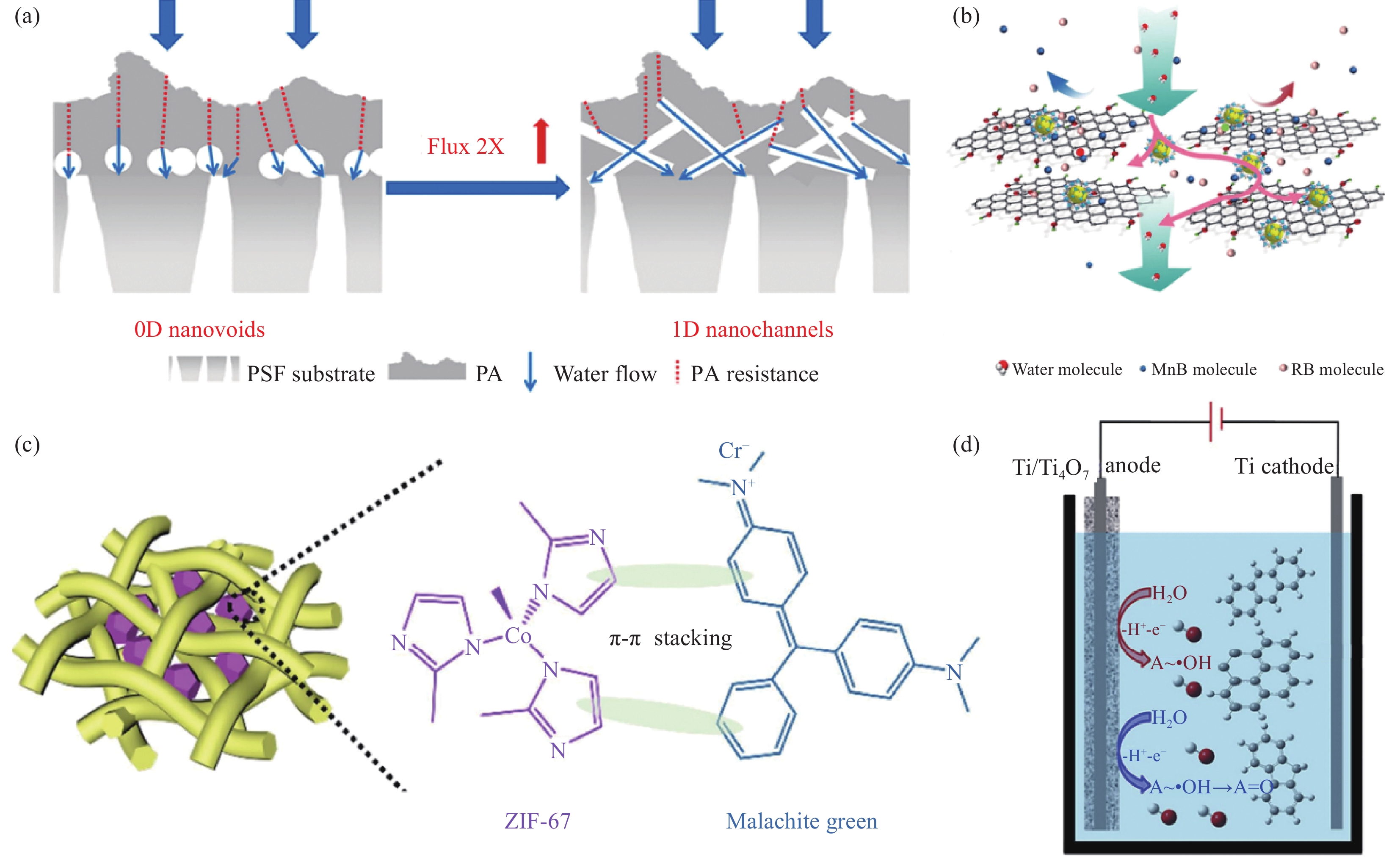
 下载:
下载:
